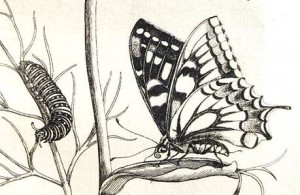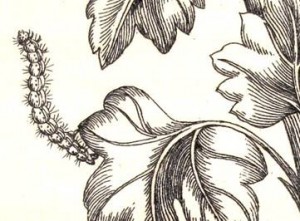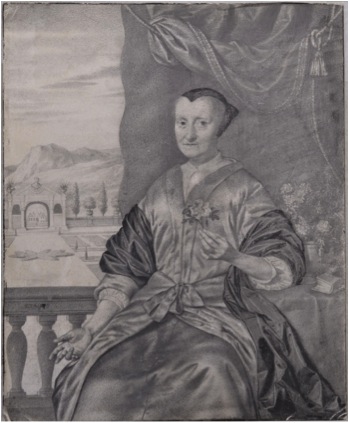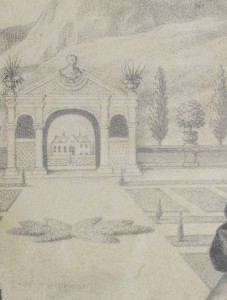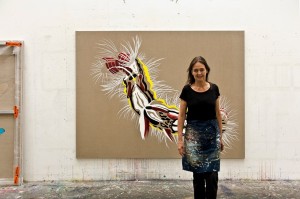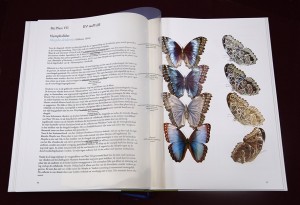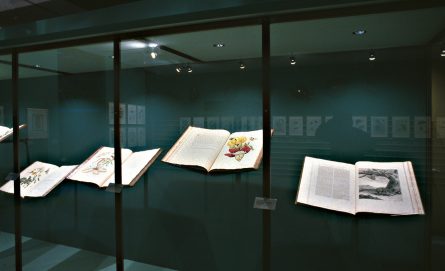The Ecology of the Raupen books, Kay Etheridge, Gettysburg College, Pennsylvania, USA
“[…] I consider it necessary to express much in few words: in general, all caterpillars, as long as the insects have mated beforehand, emerge from their eggs […]” (from the preface of Der Raupen wunderbare Verwandelung und sonderbare Blumen–nahrung, Maria Sibylla Merian, 1679).[1]

Fig. 1. Plate 40 in Merian’s first Raupen book (1679).
Published in a period when insects were thought to generate spontaneously, this bold statement from the 32-year-old Merian was reinforced by her carefully engraved image of a silkworm moth laying eggs. Raised in a family of well-known publishers, Maria Sibylla Merian (German, 1647-1717) was trained from an early age in painting, etching and engraving. However, her life’s work and passion would be the study of moths and butterflies; she raised insects for almost five decades, recording the food plants, behaviour and ecology of roughly 300 species.[2] Her most imitated and influential invention was an “ecological” composition in which the life cycle of an insect was arrayed around a plant that served as food for the caterpillar (Fig. 1); prior to Merian’s Raupen (caterpillar) books animal and plant images were segregated, usually in separate volumes.[3]
In 1699 Merian traveled to Surinam to study tropical insects, and is today best known for her magnificently illustrated Metamorphosis Insectorum Surinamensium (1705). Perhaps because of the attention drawn to the larger and more dramatic book on New World plants and insects, her three books on the less showy European organisms have been largely overlooked by contemporary scholars. This is unfortunate because her Raupen books contain observations on interactions among the species she studied over a period of decades, whereas her work on Metamorphosis was completed over a relatively short period. Furthermore, the Surinam volume portrays organisms from a much more diverse and complex tropical environment, which would have been more difficult to study even given more time. Her first two volumes on European insects,published in German, are more detailed in their descriptions than the much later third volume, and here I will discuss only the first Raupen book, published in 1679. This essay will focus on her study of factors central to ecological science, primarily her descriptions of environmental effects on insect development and abundance, and her observations on insect food choice and feeding behaviour.
Merian’s images show not only details of the insects’ life cycles such as the appearance of the eggs and pupae, but specific patterns of herbivory on plants. Almost two centuries after her death, the study of insect-plant interactions became a cornerstone in the growing fields of ecology and evolution, and thousands of papers and books have been dedicated to this critical relationship. Merian was particularly concerned with the food plants of the caterpillars, as this knowledge was essential to achieving the complete metamorphosis of the insects in captivity, but also as it was helpful to gardeners and horticulturists. However, from the specifics she also drew general conclusions that are today central to ecological studies.[4] For example, the entry below demonstrates that Merian documented what is now regarded as the important distinction between what ecologists term “specialist” vs. “generalist” feeders: “It is surprising to note that I often kept caterpillars which fed on a single flowering plant, would feed on that one alone, and soon died if I did not provide it for them. On the other hand, I kept many other caterpillars that used more than one plant for their nourishment, though for a number of these one food was preferable. Indeed, they would move immediately from one food to another that they preferred as soon as they tasted it. Then again, I have had six or more species of caterpillars with a definite taste for an assortment of things — in fact, the same things — and which fed on them with equal pleasure, such that I was more than a little surprised by it.” (Ch. 46, p. 93.) Merian frequently recounted the voracious nature of caterpillars, including (correctly) some that will cannibalize each other: “It is curious that this type of caterpillar, when they have no food, will devour each other out of sheer hunger, but will cease doing so as soon as they have food again.” (Ch. 23, p. 48.)
She understood very well that without sufficient and proper food the caterpillars would not successfully metamorphose, and she wrote in Ch. 45 (p. 92): “Finally, it is noteworthy that such ones, like all the other summer-birds [butterflies], not only alight on their food exclusively and mostly fly around such areas […], but usually lay their yellow eggs there as well. Thus, when their little caterpillars emerge from them, they might be supplied [with food] and grow to greater size.” She noted that adult moths often emerged and immediately mated without feeding (we now know that many moths do not form complete mouthparts), but she did document the feeding of some butterflies such as the swallowtail. The adult’s proboscis, shown clearly in Fig. 2, was described as: […] a long beak which it rolls up completely, and if sugar is put out for it, it will place the extended beak on the sugar as if to eat with it. It also uses it to draw the sweetness from flowers, as I have seen it do many times.” (Ch. 38, p. 78).
Both text and images are essential to appreciating Merian’s meticulous observations. In Chapter 38 (p. 77) she commented on a characteristic behaviour in swallowtail caterpillars, which if “touched hard, they immediately extend two yellow horns on the front of their head, like a snail.” Shown everted in the detail from Plate 38 (Fig. 2), these “horns” are now known to be a defensive structure that secretes an odorous compound, deterring predators such as ants. Merian addressed many other means of defense, for example the caterpillar of the moth shown belo
w right in Figure 3:
“If one touches the first kind, like the caterpillar standing upright on one green leaf, it holds fast with its hind legs and thrashes about violently with the front part of its body as if it were angry; in fact, it fastens itself so tightly that one can hardly pluck it off without injuring it.” (Ch. 25, p. 51.) Some behaviours she attributed in part to effects of weather, such as that of the pearl moth caterpillars (Ch. 7, p. 15): “When they are touched, they retreat at once, or lower themselves to the ground by a thread from their mouth, then climb deftly back up the same thread to their house, which consists of small rolled-up leaves, one of which is shown below [at the bottom of the stem]. Thus they are concealed from view and are protected and safe from the heat of the sun and the wet of the rain. When they wish to eat, they run out, and as soon as they have eaten their fill, they hurry back in; there is a constant, lively running back and forth.”
Merian did not attempt to explain everything that she observed, and in general avoided speculation, which sets her apart in another way from many other naturalists of the period. For example, she was the first to portray the seemingly inexplicable metamorphosis of very differently patterned lappet moth caterpillars (Gastropacha quercifolia) into identical pupae and adults (Ch. 17, pp 35-36), something now understood to be caused by variations in the diet of the larvae of some species. But at the end of her chapter on these “Vermes miraculosi” she wrote: “Now whence such dissimilar caterpillars come, even though [they produce] the same kind of insect, the naturalists[die Naturkundigen] can perhaps explain better.” In a more pronounced
example of her aversion to speculation Merian leaves it to other naturalists to explain another mystery. She was puzzled for years by what she thought of as “false transformations,” the emergence of parasitic insects from the larvae or pupae of moths and butterflies they use as their host (Fig. 4). In her 1679 and 1683 Raupen book as well as in Metamorphosis she documented such parasites/parasitoids a number of times. By her third caterpillar book (published 1717) she correctly explained the phenomenon.[5]
Merian was the first naturalist to draw detailed attention to animal/plant interactions with both word and image, and her work influenced many naturalists who followed her. Much of the information she first published more than three centuries ago withstands the scrutiny of modern biology, and the number of original observations in her work seems astounding in an era when most biologists focus on one or two organisms in their career.
[1] Translations in this essay are by Michael Ritterson. Merian’s original terms can cause confusion for the modern reader and so for clarity some liberties must be taken with her language. For example, Merian used samen (seed) for eggs and Vögelein (little birds) for butterflies.
[2] Used here for the sake of simplicity, the terms ecology, biology, and science came into use long after Merian.
[3] For more on the influence of Merian’s work see Etheridge, K. and F.F.J.M. Pieters. Maria Sibylla Merian (1647-1717): pioneering naturalist, artist, and inspiration for Catesby. In: The curious Mr. Catesby: A ‘truly ingenious’ naturalist explores new worlds. E.C. Nelson and D. Elliot, eds. Athens, GA: University of Georgia Press. Pp. 39-56, 2015.
[4] Etheridge, K. ‘Maria Sibylla Merian: The first ecologist?’ In: Women and Science: Pioneers, Activists and Protagonists, V. Molinari and D. Andreolle, eds. Newcastle upon Tyne: Cambridge Scholars Publishing, pp 31-49, 2011.
[5] For more on these specialized parasites and Merian’s role in understanding them see Vidal, Stefan. “The History of Hymenopteran Parasitoid Research in Germany.” Biological Control 32: 25–33, 2005.
Merian puzzles. Some remarks on publication dates and a portrait by Johannes Thopas, Hans Mulder, Curator Artis Library, Amsterdam, The Netherlands
While preparing the symposium “Exploring Maria Sibylla Merian” with Kay Etheridge, Florence Pieters, and Diny Winthagen, I came across three interesting ‘Merian puzzles’.[1] I briefly touched upon them in my introductory talk, and in this short essay I would like to speculate a bit on possible answers, partly based on new evidence.
In 2012 John Fuegi and Jo Francis – working together on a Merian documentary for several years – asked me if I, a book historian, could find information on the publishing date of Rupsen because they had serious doubts about Pfeiffer’s dates.[2] Max Adolf Pfeiffer published his renowned bibliography of the works of Maria Sibylla Merian in 1931.[3]
Rupsen was published in three undated parts. According to Pfeiffer the first part was published in 1713, the second in 1714 and the third in 1717. Pfeiffer based his assumptions on rather logical arguments, quoting Merian’s ‘Vorrede’ of Raupen (1679) as stating that she had studied the metamorphosis of the caterpillar for five years.[4] Thus Pfeiffer concludes that Merian started working on the caterpillars in 1674. In the “Voorreden” of Rupsen part one she mentions that she persisted in this research for 39 years. By Pfeiffer’s calculations this would mean that the first part of Rupsen was printed in 1713. The third part was published posthumously by Merian’s daughter Dorothea. In the preface she writes that due to the fact that her mother was ill for two years, Maria Sibylla was unable to finish her work. Dorothea did that for her after her mother died on 13 January 1717. Pfeiffer concludes that the third part was therefore published in 1717 but would have been published two years earlier, in 1715, had Merian been well enough to finish it. This leaves 1714 for the second part of Rupsen. Well, the reasoning is logical, but not waterproof. If we for instance take a close look at what Merian actually writes in her preface of Raupen, we read the following: “[…] many caterpillars or worms turn into flies or mosquitos which to my knowledge does not happen with the silkworms: as I continued to observe these insects into the fifth year and discovered wonderful changes, all of which I kept in a case and showed to anyone wishing to see them.”[5] Pfeiffer’s conclusion is not impossible: Merian could have been working for only five years on the caterpillars, but it does not literally say so. Be that as it may: all library catalogues follow Pfeiffer.
Trying to resolve this puzzle, I was lucky. The Koninklijke Bibliotheek in The Hague initiated the digitization of Dutch periodicals in 2006, and incorporated all Dutch historical newspapers. The results are currently accessible under the name ‘Delpher’. [6] Although the problem with optical character recognition (OCR) remains (one simply cannot be sure that all the text on the image was transcribed correctly into computer readable text), this website is a fantastic research tool. A quick search for ‘Merian’ in the advertisements between 1690 and 1718 resulted in eight hits, six of them referring to Maria Sibylla Merian and two to her father, Matthaeus Merian.[7] Five mention the Surinaemsche Insecten, but only one of the ads dealt with Rupsen. In the ‘s-Gravenhaegse Courant of 23 November 1712 we read that M.S. Merian announces that the second part of her European Insects is now available at her house in the Kerkckstraet close to the Spiegelstraet in the Roze-Tak. Moreover it is also available at G. Valk, Art Salesman on the Dam and G. Onder de Linden, Book salesman on the corner of the Nes and The Langebrugsteeg.[8] An extended search (Valk, Spiegelstraat, insect, rups, roze-tak in various spellings) resulted in one more ad in the Oprechte Haerlemsche Courant 31 May 1712 in which Merian not only mentions that the second part of the changes of insects is for sale at her house, but also “English salt”, or Epsom salt, which was used for medicinal purposes. [9] This information moves up Pfeiffer’s dating of 1714 by two years.

Fig. 1. Advertisement second part Raupenbuch in ‘s-Gravenhaegse Courant of 23 November 1712. (Click to enlarge)
And one might expect that part one of Rupsen would have been printed earlier, in or before 1712.
Because the years 1706 through 1711 of the Amsterdamse Courant are not yet digitally accessible, John Fuegi and I went to the Amsterdam City Archives. It took us days to work through the microfiches of the Amsterdamse Courant. We did get a couple of extra Merian hits, but none shed new light on the matter.

Fig. 2. Advertisement of one third of ‘Surinaemsse Insecta Observatien’ in the Oprechte Haerlemsche Courant of 15 November 1703. (Click to enlarge)
The year in which Merian’s Surinam Book was published is no puzzle at all because it is dated (1705). But in my ‘digital quest’ I noticed a very interesting ad about the making of the Surinam book. On 15 November 1703 the Oprechte Haerlemsche Courant mentions that “… the uncommon work of M. Sibille Merian, named Surinaemsse Insecta Observatien (with unusual butterflies …, and their metamorphosis from caterpillars and pupae …) at this moment has been completed so far that a complete third part, that can pass for a complete book, is for sale at the book and print sellers in the most distinguished cities …”.[10]
So, we now have evidence that by November 1703 Merian had a third part of her Surinam book ready for sale. This is earlier then we know from the literature. The ad in the Haerlem newspaper indicates that she sold her work in parts, probably to raise money for the completion of the book.
Also interesting is the Nota Bene with which the ad ends. It reads in translation: “The originals and the prints, as well as the animals themselves can be viewed every day, one hour before the evening, at the author’s [house] in the Nieuwe Spiegelstraat in the Rose-Tak in Amsterdam”.[11]
Going through the ‘s-Gravenhaegse and Oprechte Haerlemsche Courant in great detail seems for Merian researchers not the most obvious thing to do; it is extremely time consuming and after all, why would Merian herself have placed these ads in those newspapers and not in the Amsterdam newspapers? It must have had something to do with the expected clientele. As far as I know this question is still open for further research.
The third puzzle deals with an undated Thopas portrait, supposedly of Merian, kept by the Dutch Entomological Society, and up until recently located in the Artis Library. The drawing (plumbago, black wash on vellum) depicts a seated, elegantly dressed elderly woman. The fabric of her dress shines like silk. She wears a small black cap and in her left hand she holds a rose. To her right we see a small table with a vase and flowers and in front of the vase a small book. To her left there is a balustrade, giving the impression that the woman sits close to a balcony, which has a beautiful view on a rather exotic garden with a spacious road leading to a Roman gate set against a background of mountains. Through the gate a large mansion is visible. When we zoom in on the top level of the balustrade we can read ÆTA and a somewhat blurry figure: 59 or 79. It looks as if someone tried to erase or correct it. Merian’s name is written on the back of this picture. But is this woman indeed Maria Sibylla Merian, as for example Stuldreher-Nienhuis suggested?[12] I am not the first who has serious doubts about that assumption.[13]
Let us have a look at the facts.
Johannes Thopas was born in Arnhem around 1626 and died between 1688 and 1695.[14] Thopas was a deaf mute, born in a well-to-do family. He was taken care of by his mother, brothers and sisters all his life. Thopas worked in Utrecht, Haarlem, Amsterdam and Assendelft. From his oeuvre one painting and sixty-six lead pencil drawing (plumbago’s) have survived the ages. Many of those drawings were on display at the Thopas exhibition at the Rembrandt House Museum in 2014. Rudi Ekkart wrote the catalogue that accompanied the exhibition. Ekkart’s exemplary research presents us with all known facts about the life and works of Thopas. Catalogue number 53 is titled: Portrait of a woman, erroneously called Maria Sibylla Merian, 1679(?).[15] Ekkart does not tell us why this is not Merian’s portrait, but the question mark is understandable: 1679 is doubtful. ÆTA can be read as an abbreviation of Aetas (age or in the age of). It is more likely that 59 or 79, refers to the age of the portrayed woman or possibly to the artist.
After a stay of nearly six years in the Labadist settlement in Wieuwerd (Friesland), Merian came to live in Amsterdam in 1691. When for argument’s sake we take the latest possible death date of Thopas (1695) and then look at the dates, this picture, if of Merian and drawn from life (as one might expect), must have been made between 1685 and 1691 (Wiewerd) or 1691 and 1695 (Amsterdam). When we try to bring the dates into concordance with the ages of 59 or 79 we have a problem. Thopas was 59 in 1685, the year when Merian came to Wieuwerd, aged 38. And Merian was 59 in 1706, too late for Thopas. The other possible figure could be 79 and that causes another problem, because if Thopas died in 1695 he would have been 69. And Merian died in 1717 also in the age of 69.[16] For this to be a picture of Merian, we must assume that the drawing was made in 1685 or 1686 by a 59-year-old Thopas of a 38-year-old Maria Sibylla Merian (she then certainly must have aged very young). The garden, the gate and the house in the background would then be the Waltha mansion, the home of the Labadist settlement in Wieuwerd, and an artist’s impression as well, because it shows no resemblance to the known picture of ‘Waltha-state’ drawn by Johann Graff, Merian’s husband at the time.[17]
But there are other arguments against this being Merian, for instance: why is there no reference to her work (only a flower in her hand and in a vase, but no insects)? Why would Merian pose in a beautiful and costly dress, when she just entered the Labadist community, which demanded a renunciation of all earthly possessions?
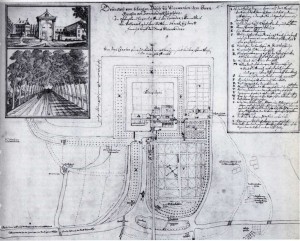
Fig. 6. Johann Andreas Graff, Ground plan and views of Waltha state, ca. 1686, Staatsarchiv Neurenberg, Rst. Nbg., Karten und Pläne, Nr. 1085. (Click to enlarge)
Ella Reitsma has suggested that the drawing shows Agnes Block and I tend to agree.[18] Agnes Block was born 1629 in Emmerich (briefly the hometown of Thopas as well) and died in Amsterdam in 1704.[19] Although she lived in Amsterdam, she and her second husband, Sybrand the Flines, owned a large mansion on the river Vecht called Vijverhof. Here Agnes did a lot of important botanical work, and her garden was visited by many, among them Maria Sibylla Merian. The large painting of Agnes Block and her husband by Pieter Weenix in 1694 shows a woman bearing resemblance to the one depicted by Thopas.[20] Interestingly in the background of the Weenix painting we see a Roman gate. The mansion on the Thopas drawings could be Vijverhof, and if we add the fact that Agnes Block was 59 in 1688, we can make a strong case for her to be the woman in the Thopas drawing.
There remains a lot to be discovered about Maria Sibylla Merian. Just more or less accidentally trying to solve three Merian puzzles, I raised a few new ones already, for instance the one about why Merian would have put advertisements in the The Hague en Haarlem newspapers and not in the Amsterdamse courant. But there still are many, many more questions. Merian is of interest for entomologist, botanists and historians from different disciplines (science, art, politics, economy, religion and the book), all the more reason for a grand conference. The newly founded M.S. Merian Society will do its utmost to bring all those researchers to Amsterdam in 2017. I hope that combining our forces will help us to better understand Merian’s life and work. And because the study of Merian includes so many research fields it should be possible to paint a more complete picture of the western world in the late seventeenth and early eighteenth century.
[1] Exploring Maria Sibylla Merian, Symposium held in the Artis Library (University of Amsterdam), Amsterdam 26 – 28 May 2014).
[2] Merian, Maria Sibylla, Der rupsen begin, voedzel en wonderbaare verandering … Naauwkeurig onderzogt, na ’t leven geschildert, in print gebragt, en in ’t kort beschreven (Amsterdam, 1713-1717).
[3] Pfeiffer, Max Adolf, Die Werke der Maria Sibylle Merian (Meissen, Dudelsackpresse, 1931).
[4] Merian, Maria Sibylla, Der Raupen wunderbare Verwandelung, und sonderbare Blumen-nahrung, worinnen, durch eine gantz-neue Erfindung…, (Nürnberg / Frankfurt, 1679), p. iii.
[5] […] aus manchen Raupen oder Würmern gar Fliegen / oder Mucken werden ; dergleichen mit den Seidenwürmeren / meines Wissens / nicht geschicht : Wie ich dann bis in das fünfte Jahr hero denselbigen stets abgewartet / und wunderbarliche Veränderungen erfahren ; solches auch für jedesmanniglich der es zu sehen verlangte in einer Schachtel aufbehalten / und gewiesen.
[6] http://kranten.delpher.nl/nl/.
[7] Merian started working in Amsterdam in 1691 and died there in 1717.
[8] M.S. Merian maekt alle Liefhebbers der Insecten bekend, dat haer Tweede Deel van de Europeese Insecten, nu te bekomen is by haer ’t Amsterd. in de Kerkstraet by de Spiegelstraet, in de Roze-Tak, als ook by G. Valck Kunstverkoper op den Dam, en by G. onder de Linden Boekverkoper op den hoek van de Nes en de Langebrugsteeg.
[9] M.S. Merian maeckt bekent aen alle Liefhebbers der Insecten, dat haer tweede Deel van de veranderinge van Insecten by haer te komen is, t’Amsterdam in de Kerckstraet by de Nieuwe Spiegelstraet in de Roosen Tack; als oock by Gerard Valck in de wekende Hont op den Dam: Sy verkoopt oock het Engels Zout, het welck plagt verkocht te werend het tweede Huys van het Wale Weeshuys, (pond) 30 Stuyvers.
[10] Wert bekent gemaekt, dat het ongemeene Werck van M. Sibille Merian, genaemt Surinaemsse Insecta Observatien (bestaende in ongemeene Vlinder-Gediertens, als Nacht- en Dag-Kapellen, nevens hare Veranderingen uyt Rupsen en Poppen, behalven voor veel andere rare Dieren van den Natuur) tegenwoordig soo verre is voltoyt, dat een volkomen derde Gedeelte, ’t geen voor een geheel Werck kan strekken, wert verkocht by de Boek- en Prent-Verkopers in de voornaemste Steden. NB. : De Originelen en Gedruckte, als mede de Natuurlijke Beesjes konnen by d’Autheur alle Dagen 1 Uur voor den Avont gesien werden in de Nieuwe Spiegelstr: in de Rose-Tak t’Amsterdam.
[11] See footnote 9
[12] Stuldreher-Nienhuis, J., Verborgen paradijzen : het leven en de werken van Maria Sibylla Merian 1647-1717 (Arnhem, 1945), p. 171.
[13] Reitsma, Ella, Maria Sibylla Merian & daughters : women of art and science (Zwolle, 2008), p. 125 (footnote 51).
[14] Rudi Ekkart, Deaf, Dumb and Brilliant: Johannes Thopas, Master Draughtsman (Amsterdam 2014). This publication accompanied the Thopas exhibition in The Rembrandt House Museum (11 July – 5 October 2014).
[15] Idem, p. 129. Ekkart wrongly writes that this drawing is now being held by Leiden University Library. The collections (specimens and library) of the Dutch Entomological Society (owner of the drawing) were moved from Amsterdam to Naturalis National Biodiversity Centre, in Leiden.
[16] Idem. Ekkart mentions another Johannes Thopas who also lived in Assendelft, but this was Thopas’ nephew (1655-1705) who work as a town clerk (p. 23, note 14).
[17] The sketch of the ground plan of Waltha-state (1686) by Johann Andreas Graff (Neurenberg, Staatsarchiv, Rst. Nbg., Karten und Pläne, Nr. 1085), shows Waltha-state in the left upper corner.
[18] Reitsma, p. 125 (footnote 51)
[19] See for a short biography (in Dutch): http://resources.huygens.knaw.nl/vrouwenlexicon/lemmata/data/Block
[20] Reitsma writes that this woman wears a Mennonite cap. This could be possible, but according to Adriaan Plak, keeper of the Mennonite collections of the UvA, it probably is a so called ‘tipmuts’, a cap worn by elderly women in Holland.
Interpreting Merian: Challenges in transcribing her manuscripts - with special attention to Merian’s work for Rumphius’s book on Ambonese rarities, Florence Pieters, Artis Liberary, University of Amsterdam
During the second half of the last century our knowledge about letters and other manuscripts written by Maria Sibylla Merian has steadily increased. Of course, the rediscovery and publication of her Book of Notes and Studies in 1976 (Leningrader Studienbuch) is a most important landmark in Merian research. However, our knowledge about her correspondence has grown rather slowly.
Up to the present, only eighteen letters have been traced. In 1944, Jantje Stuldreher-Nienhuis published four letters written to Clara Regina Imhoff in Nuremberg in the years 1683-1697. Later on, in 1967, Elisabeth Rücker published six more letters, addressed to Merian’s friend and pupil Clara Regina and to Johann Georg Volkamer in Nuremberg and written in 1682, 1685, 1702, 1704 and 1705 (of one other letter written in 1702 the adressee is unknown). In 1980, Elisabeth Rücker and William T. Stearn added seven more letters, all addressed to the apothecary James Petiver in London, written in the years 1703-1712. For transcriptions of all hitherto known letters written by Maria Sibylla Merian, click here.
Discovery of the last Merian letter
As early as 1961, the great Dutch art collector Frits Lugt (1884-1970) bought an as yet unknown letter written by Merian in 1711, addressed to the historian and numismatist Christian Schlegel (1667-1722) in Arnstadt. The letter is still kept in the art historical study centre Fondation Custodia in Paris, founded by Frits Lugt.[1] It remained for a long time unnoticed, until a photocopy of the letter was passed on to me after a successful cooperation between the Artis Library and the Fondation Custodia in 1983, when both institutions contributed to a large Merian exhibition in the Rosenborg Castle in Copenhagen.[2] I read the letter immediately and then I felt very lucky, as its contents seemed to be fairly important. It is a business letter in which she gives the prices of her published works: uncoloured, coloured regular copy, and coloured counterproof copy. After seeing this letter, I looked out for a good opportunity to make it public.
The best occasion was of course Merian’s 350th birthday in April 1997, so I had to keep it secret for a long while – and “patientia is a good little herb” as Maria Sibylla wrote in her letter to Johann Georg Volckamer at the end of July 1704 (letter 13). Finally, when Kurt Wettengl visited the Artis Library to arrange various loans for his large Merian exhibition in Frankfurt am Main in 1997, I told him my secret and he was very enthusiastic about it. Of course he wished to publish the letter in his catalogue and thus the catalogue contains transcriptions of all eighteen hitherto known letters written by Merian.[3] In Amsterdam festivities were organized on the occasion of Merian’s birthday as well: for instance, the elocutionist Corien Barneveld recited parts of the long poem on Merian by Bertus Aafjes[4] in the Royal Hall of the Zoological Society Natura Artis Magistra, accompanied by baroque music. Later that April, I enjoyed giving a talk in commemoration of the 350th anniversary of Merian’s birth at the University of Virginia in Charlottesville, USA. I presented the letter written in 1711, gave a translation and discussed its contents. It was a preliminary talk on the eve of the international conference “The natural bridge – the transatlantic exchange” organized by the Society for the History of Natural History. That talk was later remodeled into an article, co-authored by Diny Winthagen, and published in the Society’s journal Archives of Natural History in 1999. The article contained a good photographic copy of the original manuscript.[5]
An important error in the transcription
Later I sent reprints to my Merian friends, including Brigitte Wirth in Göttingen. From her article published in 2007 I knew that she is very good and precise in transcribing letters.[6] In her reply she pointed to a transcription error: instead of “in & erwogen” (which does not make sense) it should read: “in 3 wogen”, meaning “within three weeks”. This meaning is also missing in Elisabeth Rücker’s transcription in Wettengl’s catalogue. The correct transcription of this letter (letter 17) can be found here on the Society website, wherein all transcriptions have been carefully checked by Brigitte Wirth.
Why is the precise transcription of this phrase so important? It concerns the colouring of two parts of the caterpillar book, in counterproof, for the price of 20 Dutch guilders “deren eines in 3 wogen hoffe gethan zu haben”, translated: “of which I hope to have done one within 3 weeks”. So this gives us some information about the amount of time required to execute such colouring in her workshop.
Presently I can thus give the correct translation of the letter (cf. Figs. 1 and 2):
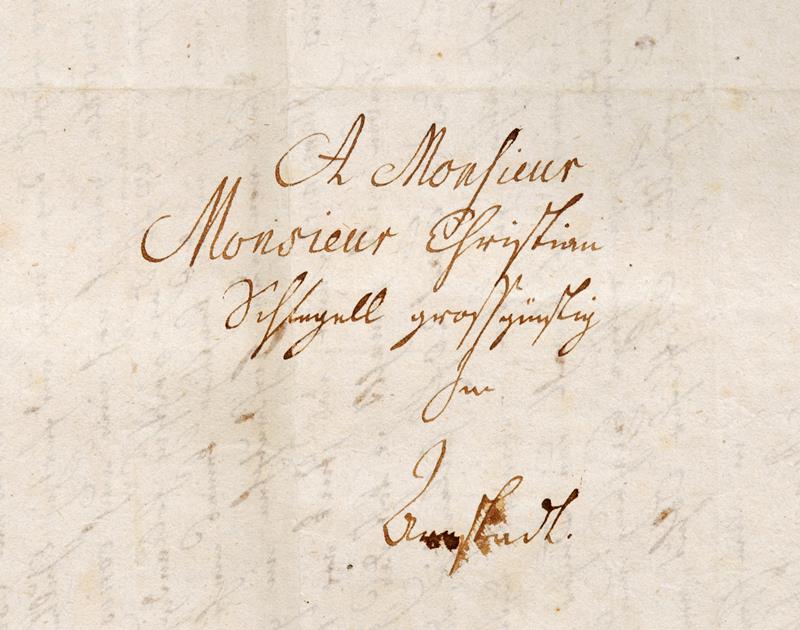
Fig. 1. Facsimile of address of Merian’s letter to Christian Schlegel in Arnstadt, dated 2 October 1711, courtesy of Fondation Custodia, Paris. (Click to enlarge)
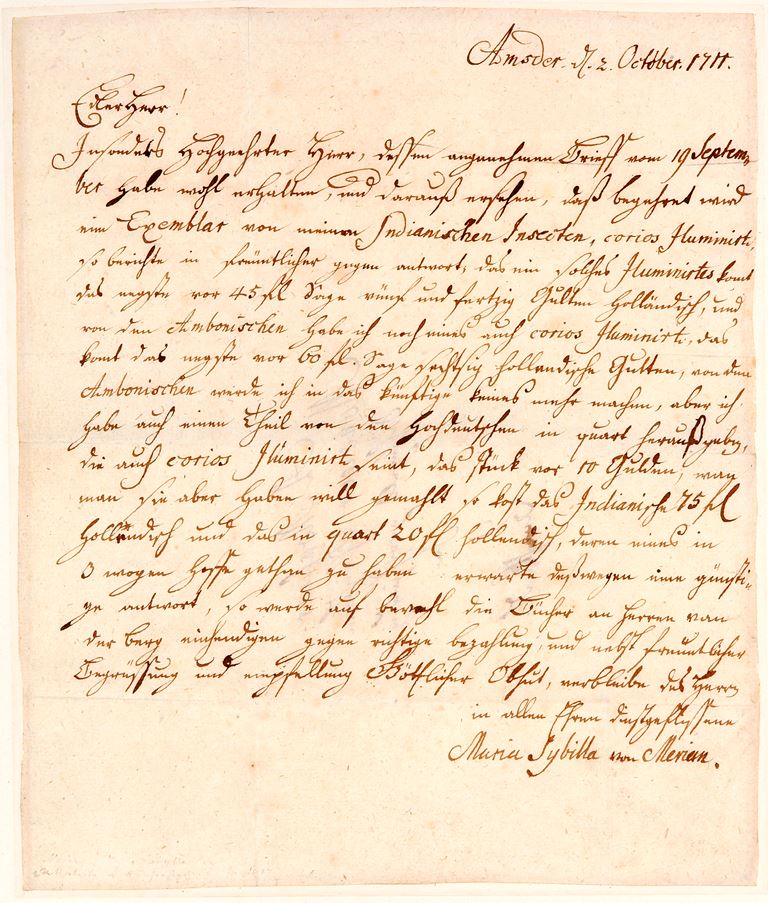
Fig. 2. Facsimile of Merian’s letter to Christian Schlegel in Arnstadt, dated 2 October 1711, courtesy of Fondation Custodia, Paris; click to enlarge the initially wrongly transcribed “3 wogen”. (Click to enlarge)
To Monsieur
Monsieur the generous Gentleman
Mr Christian Schlegell [sic]
in
Arnstadt
Amster[dam], October 2nd 1711
My Lord!
With regard, most esteemed Sir, to your kind letter of September 19th,
which was received in good condition and from which is understood that you wish to have
a copy of my Indian Insects, curiously illuminated,
I kindly reply that such an illuminated copy may now be obtained
at the price of 45 florins, verbally forty-five Dutch guilders, and
from the Ambon [book] I still have one copy left, also curiously illuminated, which
can be had for 60 fl, verbally sixty Dutch guilders. From the
Ambon [book] I will not make more copies, but I
also [have available] a volume I have published in High German in a quarto edition,
curiously illuminated too, 10 guilders a volume. When,
however, one wants them painted, the Indian [book] [amounts to] 75 fl
Dutch and the quarto [work] 20 fl Dutch, either of which I
hope to have done within 3 weeks, therefore expect a favour-
able reply, so that, if indeed required, the books may be delivered to Mister van
der Berg against proper payment. Concluding with friendly
greetings and commended with God’s blessing, [I] remain faithfully my lord’s
dedicated servant
Maria Sybilla von Merian [sic]
Interpreting Merian’s letter
(1) With “a copy of my Indian insects” she means her Metamorphosis Insectorum Surinamensium, published in 1705, and with “a volume I have published in High German in a quarto edition” she is referring to her two Raupen books on European caterpillars published in 1679 and 1683. Please note that she writes “my Indian insects” and “a volume I have published”.
(2) With the Ambon book she means G.E. Rumphius’s D’Amboinsche Rariteitkamer, (“The Ambonese Curiosity Cabinet”), published for the first time in the same year (1705) as her Metamorphosis Insectorum Surinamensium. Rumphius’s book contains little original work by M.S. Merian, while several other artists are known who made original work for the engravings in the book (see below). This also explains why she indicates the book as the Ambon book, not as my Ambon book. However, handcoloured copies of Rumphius’s book could be ordered from her workshop, of which at least one copy is known.[7] As to the Rumphius book, she seems to have been mainly concerned with colouring the plates.
(3) She writes “From the Ambon [book] I will not make more copies”. This seems logical, because the copperplates were no longer available to her at the time, since in the same year 1711 the so-called Latin edition of Rumphius’s book was published in Leiden.[8]
(4) “Curiously illuminated” means with nicely handcoloured engravings and with “painted” she means handcoloured counterproof copies.[9] In her workshop also one complete set of the plates for Rumphius’s book was copied on parchment, just as was done with three copies of Metamorphosis.[10] These drawings made up part of a set of about 200 large drawings on parchment that were bought for Czar Peter the Great, which are still present in the library of the Russian Academy of Sciences in St. Petersburg.[11] Please note that these so-called “Rumphius drawings on vellum” contain but few original work by Maria Sibylla Merian, though these gouaches have been painted in her workshop![12]
(5) She used her own press for printing the plates for her own books, printing plainly or in counterproof.[13] After ordering, hand-coloured books in counterproof could be delivered within three weeks.
(6) The prices for her books, though expensive, hardly changed during her lifetime. It is also clear that the coloured counterproof copies were mostly made on demand.
(7) She signs as Maria Sibylla von Merian. Probably the letter was addressed to her with this noble name and she thought this was good publicity. Her nephew Johann Mathaeus von Merian (1659-1716), son of Maria Sibylla’s half-brother Matthaeus Merian the Younger (1621-1687), was likewise a famous painter and engraver, just as his father and grandfather. He continued the illustrious Merian firm and eventually was even raised to nobility, hence his name was expanded by adding “von”.
More about Merian’s work for Rumphius’s book
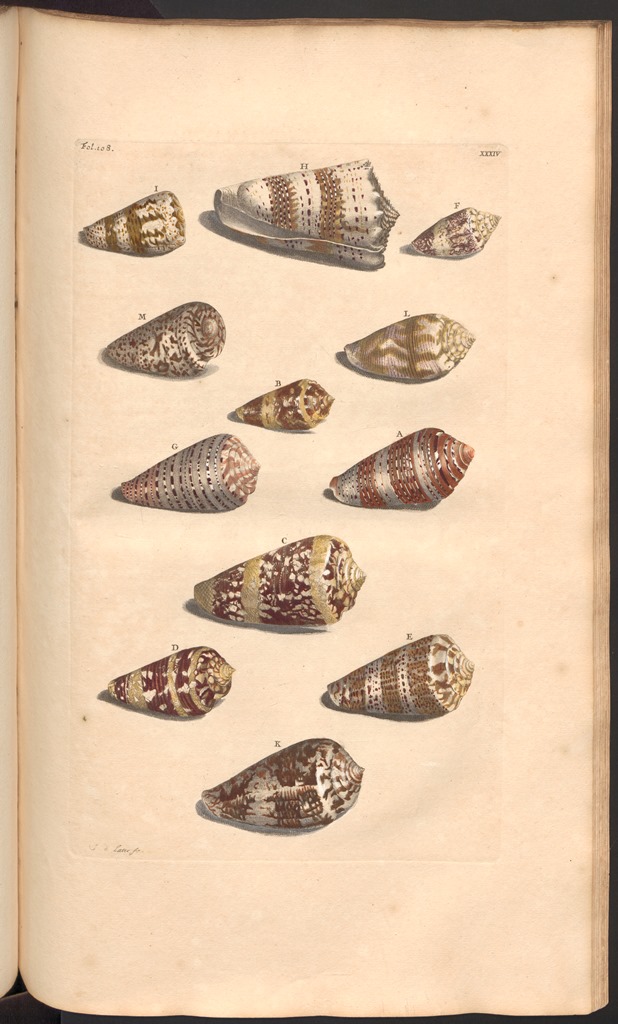
Fig. 3. Plate XXXIV in Rumphius’s book, from the copy said to be hand-coloured by Merian in the Artis Library, University of Amsterdam. Click to enlarge Figs. A and H. (Click to enlarge)
Let us now have a closer look at the plates in Rumphius’s book. On plate XXXIV (Fig. 3), the editor Simon Schijnvoet (1652-1727) wished to show the rarest and most beautiful cone shells to the collectors, adding several shells occurring outside Ambonese waters. By doing so, Schijnvoet wanted to make the book more attractive to shell collectors in general. The cone shell shown as nr. A on this plate is the Orange Admiral, Conus aurisiacus L. 1758, according to Simon Schijnvoet “Of all that comes from the Sea, especially the Toots, this is the most beautiful Whelk I know. The honourable Mr. D’Aquet, Mayor of Delft, who is often mentioned here, is the only one who owns one, and no other is known anywhere else.” [14]
This shell could have been drawn by Maria Sibylla from the only specimen known at the time, owned by Hendrik d’Acquet (1632-1706), a friend of Rumphius who received many original specimens as well as the original manuscript of the book from him. The original drawing for the book does not occur in the so-called d’Acquet Atlas[15], though it can be found unsigned and uncoloured in an album once owned by Schijnvoet, entitled Dessins originaux des Raretés d’Amboine par G: E: Rumphius in the Royal Library in The Hague.[16] However, Merian certainly did not make all these drawings, as two of these are signed by Pieter de Ruyter, Rumphius’s collaborator at Ambon, while the “rock crab” on plate IX, likewise from d’Acquet’s collection, is signed “J: Lamsveld: del: fec.”, so this crab has been drawn as well as engraved by Jan Lamsveld (1673-1743 or later). Moreover, several of the most beautiful shells in the book could neither be traced to the Schijnvoet album, nor to the d’Acquet Atlas.
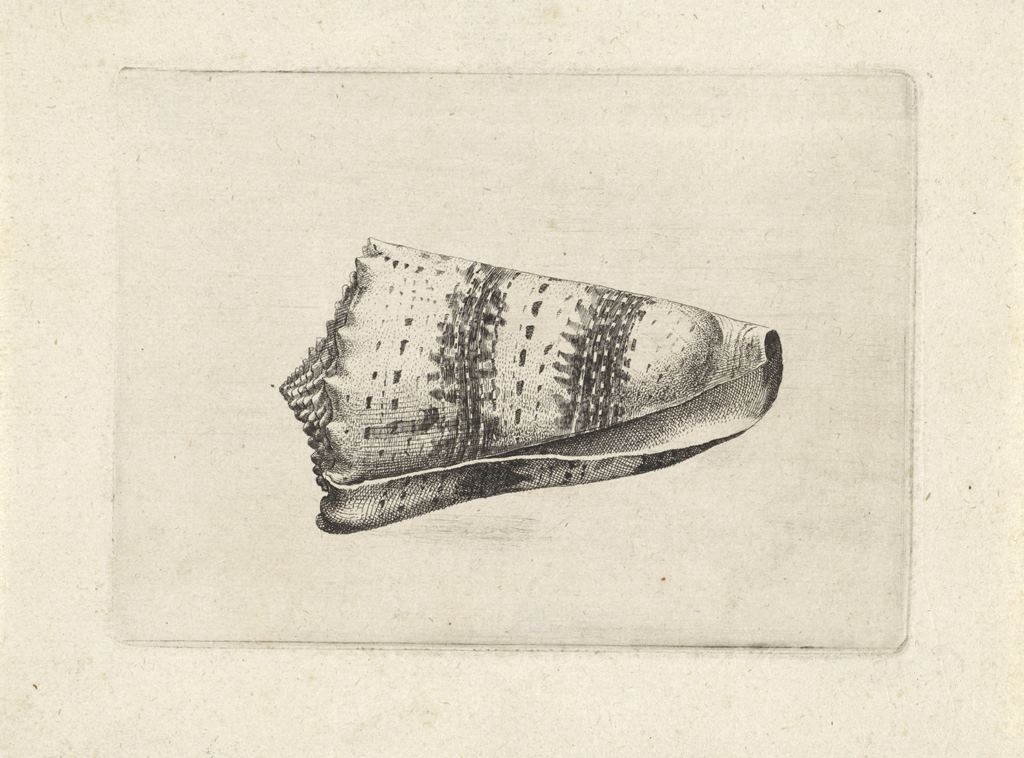
Fig. 4. Imperial cone shell Conus imperialis. Etching by Wenzeslaus Hollar, courtesy of Rijksmuseum, Amsterdam. (Click to enlarge)
Accidentally, I discovered that the magnificent imperial cone shell Conus imperialis in the upper center (H) is an exact copy of an etching by the famous artist Wenceslaus Hollar (1607-1677; see Fig. 4). That is also the reason why this is the only shell on the plate that is correctly figured as right-coiled. All the other shells on this plate are incorrectly figured as being left-winded, representing their mirror image – a rare occurrence in nature and certainly the result of printing from an engraved image. If a counterproof is made from a still wet print of this plate, all shells except the imperial cone would be correctly figured as RIGHT-coiled. The Artis Library owns such a coloured counterproof copy of Rumphius’s book, as well as a “regularly” coloured copy, said to be coloured by Merian herself.[17]
Seven more copies after etchings of shells by Hollar can be found in Rumphius’s book.[18] Now it is clear why Merian is not separately mentioned as artist for the book, as none of the artists are mentioned – only the engravers have signed their engraved plates.[19] In my opinion, the set of “Rumphius drawings” by Merian in the Academy of Sciences in St. Petersburg[20] consists of beautifully coloured drawings on parchment, mostly copied from the engravings after publication. I am looking forward to continue the discussion about Merian’s participation in Rumphius’s book at the Merian conference in June 2017.
Conclusions
(1) When publishing important manuscripts that are difficult to transcribe, it is advisable to publish facsimiles of the written text along with the transcription. This is for instance very well achieved in the facsimile of Merian’s Studienbuch.[21]
(2) Transcription of old manuscripts should be teamwork.
(3) Merian’s participation in the preparation and production of the plates in Rumphius’s book is questionable.
References
Aafjes, B., [1946]. Maria Sibylla Merian. Amsterdam.
Beekman, E.M., 1999. The Ambonese Curiosity Cabinet – Georgius Everhardus Rumphius; translated, edited, annotated, and with an introduction by E.M. Beekman. New Haven & London.
Benthem Jutting, W.S.S. van, 1959. Rumphius and malacology. In: H.C.D. de Wit (Ed.), Rumphius Memorial Volume: 181-207, pls. 17-22. Baarn.
Klein, A. & N. Klomp, 1983. Maria Sibylla Merian (1647-1717). [Catalogue of an exhibition in Schloss Rosenborg]. København.
[Merian, M.S.] Gräffinn, M.S., 1679. Der Raupen wunderbare Verwandelung und sonderbare Blumen-nahrung. Nürnberg. [Merian, M.S.] Gräffin, M.S., 1683. Der Raupen wunderbare Verwandlung und sonderbare Blumen-nahrung…. Anderer Theil. Frankfurt am Main.Merian, M.S., 1705. Metamorphosis Insectorum Surinamensium. Amsterdam.
Merian, M.S., 1976. Schmetterlinge Käfer und andere Insekten. Leningrader Studienbuch. Leipzig and Luzern. [Also available in unchanged facsimile edition, Saarbrücken 2011.]
Merian, M.S., 2003. The St. Petersburg watercolours; edited and with an introduction by Eckhard Hollman; with natural history comments by W.-D. Beer. Munich.
Mulder, H. & M. van Delft, 2016. The production of Metamorphosis insectorum Surinamensium 1705. In: M. van Delft & H. Mulder eds., Maria Sibylla Merian, Metamorphosis insectorum Surinamensium – Transformation of the Surinamese insects 1705. Tielt.
Pieters, F. & R. Moolenbeek, 2005. Rare schelpen en schaaldieren. Raadsels rond de illustraties bij D’Amboinsche rariteitkamer van Georgius Everhardus Rumphius. Jaarboek van het Nederlands Genootschap van Bibliofielen, 12 “2004”: 111-136.
Pieters, F. F.J.M. & L.C. Rookmaaker, 1994. Arnout Vosmaer, grand collectionneur de curiosités naturelles, et son Regnum animale. In: B.C. Sliggers & A.A. Wertheim, Le zoo du prince – La ménagerie du stathouder Guillaume V: 10-38. Haarlem.
Pieters, F.F.J.M. & D. Winthagen, 1999. Maria Sibylla Merian, naturalist and artist (1647-1717): a commemoration on the occasion of the 350th anniversary of her birth. Archives of Natural History, 26 (1): 1-18.
Roemer, G. M. van de, 2005. De geschikte natuur. Theorieën over natuur en kunst in de verzameling van zeldzaamheden van Simon Schijnvoet (1652-1727). Ph.D. Thesis, Amsterdam.
Rücker, E., 1967. Maria Sibylla Merian, 1647-1717 [Katalog der Ausstellung vom 12. April bis 4. Juni 1967, Germanisches Nationalmuseum Nürnberg]. Nürnberg.
Rücker, E., 1982. The letters. In: Rücker, E. & Stearn, W.T. (Eds.) Maria Sibylla Merian in Surinam. London: 61-75.
Rumphius, G.E., 1705. D’Amboinsche Rariteitkamer [Ed. S. Schijnvoet]. Amsterdam.
Rumphius, G.E., 1711. Thesaurus Imaginum Piscium Testaceorum. Leiden.
Stuldreher-Nienhuis, J., 1944. Verborgen Paradijzen. Het leven en de werken van Maria Sibylla Merian 1647-1717. Arnhem.
Wettengl, K. (Ed.), 1998. Maria Sibylla Merian 1647-1717 Artist and Naturalist. Berlin. (Edition in German published 1997 and in Dutch 1998.)
Wirth, B., 2007. Maria Sibylla Merian, Baltasar Scheid und Richard Bradley – Die Künstlerin und Naturforscherin, ein Kaufmann und ein Botaniker. Annals of the History and Philosophy of Biology, 12: 115-153.
[1] Inv. nr. 7578. Provenance: Messrs J. Pearson & Co. (cf. London, Sotheby, 23 June 1924, No. 53 to
Maggs); Maggs (cat. 457, Christmas 1924, No. 2282; Gentili de Giuseppe; Hoepli, Milano; Frits Lugt,
acquired 20 November 1961).
[2] For the catalogue, see Klein & Klomp (1983).
[3] Wettengl, K. (Ed.), 1997, letters transcribed by E. Rücker on pp. 262-269.
[4] Aafjes, B., 1946 (also later editions). The late Prof. Hendrik Engel has informed me that Bertus Aafjes was inspired to make these verses after seeing the beautifully coloured copy of Metamorphosis Insectorum Surinamensium (ed. 1719, shelfmark: AB Legkast 019.01) in the Artis Library, University of Amsterdam.
[5] The letter is published in facsimile in Pieters & Winthagen (1999), p. 11.
[6] Wirth, B., 2007. See also her essay on the present website here.
[7] Such a copy said to be coloured by Merian herself is present in the collection of the Artis Library, shelfmark Legk. 005; cf. Pieters & Rookmaaker (1992), pp. 20-23; see also Fig. 3.
[8] See Rumphius (1711). This edition printed in Leiden is predominantly a reproduction of the plates from his 1705 work, containing only 24 pages of printed text, mainly in Latin. Before that time, the copperplates were in Amsterdam, where Merian had probably easy access to them.
[9] See e.g. Mulder & Van Delft (2016), p. 43-44.
[10] Metamorphosis gouaches on parchment are present in London (Windsor castle and British Museum) and St. Petersburg, see e.g. Pieters & Winthagen (1999), p. 6.
[11] All drawings in this collection are reproduced in Merian (2003); this collection has been previously published in larger format as Leningrader Aquarelle in 1974.
[12] See below.
[13] See Mulder & Van Delft (2016), p. 43.
[14] Translation from Beekman (1999), p. 154. The Orange Admiral Conus aurisiacus seems to be still a rather rare species, occurring in seas off Australia up to the Philippines. I take this beautiful shell as example because Merian drew in 1709 a very good copy of this magnificent shell in the album amicorum of the famous engraver and publisher Petrus Schenk (1660-1711), present in the University Library Leiden (shelfmark: LTK 903, f. 101v-102r). I will return to this subject during the international symposium in Amsterdam, 7-9 June 2017.
[15] The d’Acquet Atlas is now in the Special Collections section of the Library of the University of Leiden, shelf number: RF-281. The title reads: Insecta et animalia coloribus ad vivum picta, anno 1656 et sequentibus : opus magnificentissimum et unicum, nobilissimus dominus Henricus d’Acquet, civitatis Delfensis senator ac consul, ad exemplaria naturalia summo studio ultra quinguaginta annos ex universis terrarum oris quaesita et in sua collectione conservate pingere curavit. The manuscript is dated 1656-1708.
[16] Shelfmark 68A3. This album contains 566 drawings pasted on 45 folio pages; see e.g. Van Benthem Jutting (1959: 193-194), Van de Roemer (2005: 60) and Pieters & Moolenbeek (2005: 117).
[17] Shelfmarks: Legk. 005 and Legk. 006 (counterproof copy). According to Van Benthem Jutting (1959: 205), the counterproof copy of Rumphius’s book was prepared after the 1741 edition, so Maria Sibylla Merian cannot have been the artist responsible for the illumination of this volume.
[18] See Pieters & Moolenbeek (2005).
[19] The names of the engravers are only indicated on the plates of the first edition of Rumphius’ book, NOT in the later editions published in the 18th century.
[20] The St. Petersburg watercolours/gouaches are reproduced in Merian (2003; also in earlier larger edition entitled Leningrader Aquarelle, published 1974).
[21] Merian (1976).
How the Metamorphosis lead to the Portfolio, Joos van de Plas, artist, Helvoirt, The Netherlands
Although I knew about Maria Sybilla Merian and appreciated her work during my years at the Art Academy, it was not until the turn of the century that I began to research her and her work more seriously.
In fact it started in 2004, when I was fortunate to obtain permission to borrow a complete facsimile of Merian’s Surinam book from the city library of Tilburg. It was the first time I saw her magnum opus in its totality, and it made an overwhelming impression on me. I drew rough copies of a few pages in my sketchbook, and so rekindled my lifelong interest in insects (Fig. 1). It did not take long before I started to make my first tentative appointments with museums and libraries to see those beautiful tomes of scientific drawings made from the sixteenth century onwards.
Merian entered my studio on tiptoe, as it were. The row of entomological reference works, books on Merian and facsimiles of well-known nature books expanded to claim more and more shelf space. But, not satisfied with just that, I went to Surinam to see with my own eyes what Merian must have witnessed three centuries earlier. I did some research there, collected and sketched a lot, and I visited those spots in the Surinam forest where once the plantations stood, the places where she had done her research. Real expeditions they worked out to be, complete with a machete-wielding guide to reconquer a narrow path through the jungle for me and my companions.
But this trip, although I hate to confess it, didn’t bring me that much closer to Merian. For that to happen I had to wait two more years when a distant relative in Germany sent me an article that was published in the newspaper Frankfurter Allgemeine. It was an interview, in which Fritz Geller-Grimm, the curator of the Natural History Department in Museum Wiesbaden, described a spectacular part of its entomological collection. It dated back to the seventeenth century. This so-called Gerning Collection, he revealed, included Surinam butterflies which might have been collected by Maria Sibylla Merian herself!

Fig. 2. Front cover of the Art Book Portfolio Wiesbaden, the first copy of which has been acquired in 2014 by the Artis Library, University of Amsterdam.
So I plucked up courage and I phoned Herr Geller-Grimm. We made an appointment. He proved to be an energetic, enthusiastic man who was proud of his collection and open to new ideas. He lost no time in accompanying me to the basement of the museum. Suddenly I found myself face to face with the Gerning Collection, that venerable collection of insects about which I had read. A wall of room-high cabinets glared sternly down at me. I was told that they contained a good 40,000 insect specimens. The thought that some centuries-old Surinamese butterflies might be in that collection spurred me on, and it was not long before I had a number of intriguing boxes in front of me. Each box had a glass top and bottom, and sides stuck with ultramarine blue paper. Tattered butterfly wings ogled me through the glass tops. I had arrived at a place which was to become my stamping-ground for quite some time to come.
Assisted by the staff of the museum, I gradually worked my way through the collection. In an atmosphere of eagerness tempered by caution, I worked for days at a time under the fluorescent basement lighting days mainly made up of making an inventory of what I saw. I filled memory cards full of photos, sketchbooks full of drawings and exercise-books full of notes. To take a break from this concentrated work I spent some time examining the black and white plates of the Metamorphosis Insectorum Surinamensum in the museum library.
It was, I think, during my third visit that I was struck by a tantalizing idea. The collection of butterflies was there, and so was Merian’s book; why shouldn’t I bring the two together? It might be possible to decide whether some of the specimens in the collection had actually been used for the engravings. It was a simple idea, but apparently no one had thought of it before.
This idea had occurred to me because of something I had just read in a letter Merian had written to a Doctor Volckamer in 1702; in this letter she mentioned that she was drawing her insects life-size, and if so some of the butterflies in the Gerning Collection ought to match exactly to the butterfly illustrations in Metamorphosis. A careful optical comparison should be enough to start with. It quickly became clear when comparing the butterfly wing shapes and patterns that there were indeed some astonishing correspondences, and my enthusiasm was so great that I decided to commit myself to it as a project.
As it turned out, this was truly an undertaking that had been waiting for me to discover all along. Carefully comparing dried insects with their drawn counterparts is simply not enough to draw conclusions. One must be able to follow the ‘translation’ from reality into a drawing, a painting or an engraving. A drawing from nature is inevitably partly subjective in its interpretation of the real object. I often noticed, for instance, that a drawing of an insect from life proves to be just a little larger when measured than its three-dimensional counterpart. It is simply a fact of perception that a solid object appears larger to the eye than a pattern of black lines on white paper. Another source of subjectivity is when Merian’s coloured-in drawings were reinterpreted by an engraver, for Merian engraved only two or three of the plates from Metamorphosis herself. This again is a ‘translating’ process and it certainly helps you to understand the difficulties and the impossibilities of it when you have made etchings and engravings yourself.
While fully engaged in the Wiesbaden project, I also had to visit the many contacts I had built up in the entomological world, in order to consult them about Merian’s illustrated insects, some of which have not yet been identified with any certainty. I also wanted to learn about other historic butterfly collections, if only for the sake of comparison. For years I have been travelling to museums and libraries in Amsterdam, Leiden, Haarlem, London, Berlin, Frankfurt and elsewhere, in order to research insect collections and to consult relevant old books.
In the Naturalis Biodiversity Centre in Leiden, for example, I had the opportunity to study the eighteenth-century Cramer Collection which also includes a remarkable section of antique butterfly specimens from Surinam. In the Natural History Museum in London they showed me samples of the respectable Sloane and Petiver Collections from the museum’s vaults. With my growing expertise I was even able to discover a possible link between that collection and Merian. For some years I was able to profit from the extensive collections and knowledge within the Netherlands Entomological Society in Amsterdam. It was by these means that I trained my eye and my memory, while at the same time my notebooks began to bulge with the information I was gathering for my project.
Another result was that my own collection of butterflies and moths was growing. The number of butterflies, especially specimens from Surinam, continued to expand considerably. Rather than being occupied solely with dead creatures, I started breeding caterpillars myself. This involved a daily expedition to obtain fresh leaves for my gluttonous, hairy little guests, a specific leaf for each species. I sat up many a night so as not to miss that magic moment when a butterfly emerges from its chrysalis and I started filming these fascinating events.
I am filming still! In fact, the years this research took me have had an enormous impact on my work as an artist. It brought me so many new ways of looking at my subject-matter that my painting had to take a back seat.
Instead of painting I started working on an ambitious artist’s book about my project. It would take me five years. I named it Portfolio Wiesbaden, and it had grown into a bulky book when it saw the light of day (Fig. 2). It is loosely based on Merian’s Suriname book and it consists of two parts. In Part One I present all the insects from Metamorphosis Insectorum Surinamensium for which I found a close match in the Gerning Collection.
The second part of the book gave me the freedom to give it a more relaxed, painting-like character. Here I show those butterfly specimens which do not correspond closely to the drawings in Metamorphosis (Fig. 3).
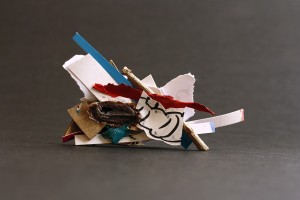
Fig. 4. Sleeping Beauty, no. 10, 10,8 cm x 7,5 cm x 2,3 cm cocoon, cardboard, acrylic, paper, branch 2013
When I see my book now I am glad to find that it amounts to anything but dry, academic science. It has become a series of intriguing, colourful adventures that shows the results of my research first and foremost through the reader’s aesthetic sensibilities.
In the years that I was putting the book together, I had some cages with caterpillars that were ready to start making their cocoons, among them some of a family that make their temporary homes by cementing particles of wood and other plant-matter together. Seeing that happen I got the idea of giving them small pieces of coloured paper, snippets of drawings and other studio debris. And really, they started constructing small villa’s from the stuff, they had a crack at all sorts of styles, from Neue Sachlichkeit to Deconstructivist. My hungry guests had become my co-workers! (Fig. 4)
So, to conclude, I am happy to tell you that my research into the Gerning Collection has given me a lot of new impulses. Following them I keep finding unexpected viewpoints. And that is exactly what an artist lives for.
Merian’s holistic view of the tiny, Katharina Schmidt-Loske, Biohistoricum, Zoologisches Forschungsmuseum Alexander Koenig, Bonn, Germany
To reveal the distinctive features of Merian’s paintings and etchings, some entomological motifs were analyzed from my point of view as a biologist. To demonstrate characteristic features of her work, it was decided to compare her entomological motifs with those used by several artists from the 17th and 18th century, i.e. Wenceslaus Hollar, Johannes Goedaert, Herman Henstenburgh, Anton Henstenburgh and Johannes Bronckhorst.
The Bohemian etcher Wenceslaus Hollar left Prague at the age of 20. He worked in Germany, England, and the Low Countries. In his diverse opus, he also dedicated himself to drawings of tiny things from the natural world. In London he became acquainted with the natural curiosity cabinet of Lord Arundel, who employed him as an etcher for the catalogue of his insect collection. W. Hollar’s collection of plates, Muscarum Scarabeorum, Vermiumque Varie Figure & Formae (1646), was made in quarto and comprises 11 plates plus a title page. It presents 61 figures of insects. Hidden behind the terms Muscarum [flies], Scarabaeorum [beetles] and Vermiumque [worms], the etchings show butterflies, grasshoppers, single beetle species, dragonflies, wasps, and bumblebees. Another entomological opus by Hollar deals with winged insects, Diversae Insectorum Aligerorum, Vermiumque; etc. […], and it shows pinned specimens. In many cases the morphological details of butterflies, e.g. mouthparts (palpae), antennae, and eyes, are illustrated in detail.
The artist Johannes Goedaert from Middelburg published and illustrated a regional insect fauna, Metamorphosis Naturalis, between 1660 and 1669, consisting of three volumes. His plates show a sequence of caterpillar, pupa, and butterfly, but rarely eggs. Some of his insect motifs can be found almost unmodified in his still-life oil paintings, for instance the Red Admiral (Vanessa atalanta) in ‘Bouquet in a Chinese vase with insects and a snail by Joh: Goedaert’. [http://www.zeno.org/Kunstwerke/B/Goedaert,+Johannes%3A+Blumenvase?hl=gri048].
This species belongs to the family Nymphalidae, the “four-footed” butterflies. Their forelegs are extremely reduced in size, and are not used in locomotion but are modified into cleaning tools instead. The Red Admiral is again depicted in Goedaert’s copper plate (Metamorphosis, part 2 [1667], plate 39), and in this figure it is shown with the correct number of visible legs.
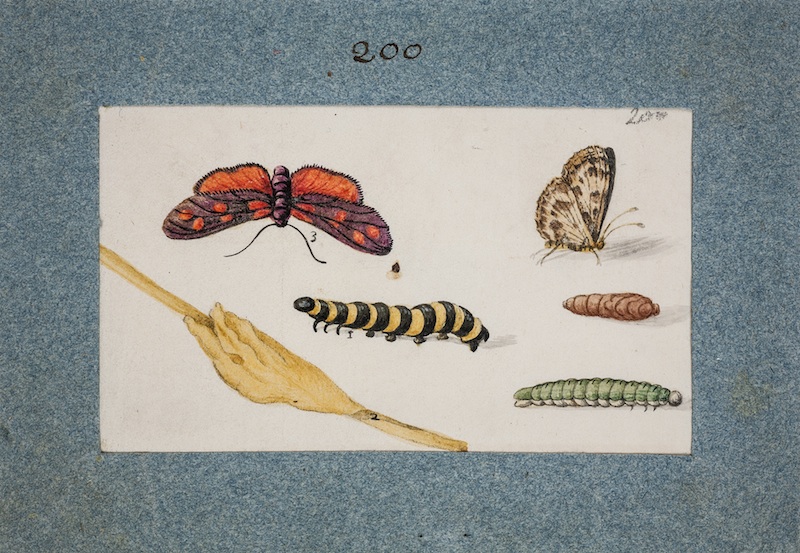
Fig. 1: Studienbuch pl. 74 fig. 200, Library of the Russian Academy of Sciences, St. Petersburg. (Click to enlarge)
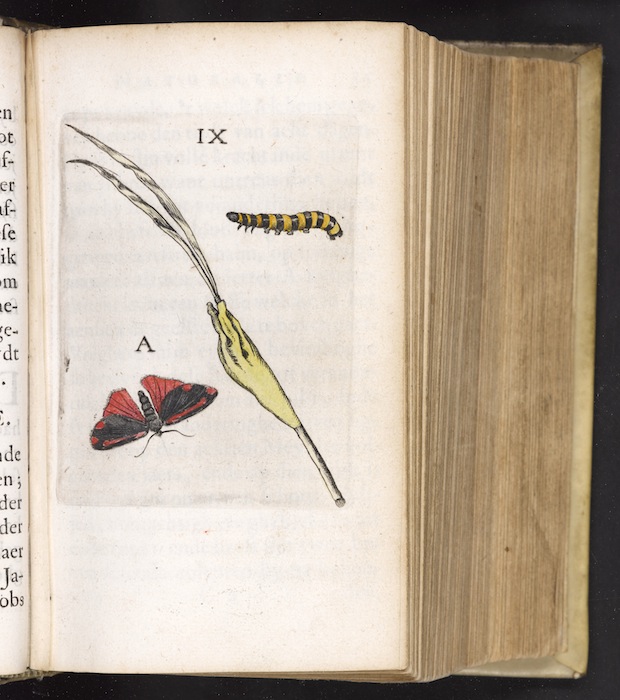
Fig. 2: Joh. Goedaert Metamorphosis Naturalis, part 1 (1662), Special Collections UvA: OTM OK 63-2217 (1), pl. IX. (Click to enlarge)
Merian was familiar with Goedaert’s Metamorphosis and used Goedaert‘s books as an important source of information. This is evident from notes in her Studienbuch; as a metaphor of resurrection, Goedaert’s [incomplete] life cycle of the Goat Moth (Cossus cossus), Metamorphosis (part 2, plate 33), was highly valued by Merian.[1] – One illustration (Fig. 1) in her Studienbuch depicts part of the life cycle of a Burnet moth. Here she adopted or copied motifs from Goedaert’s moth illustration, plate IX (Fig. 2). However, Goedaert depicted a different species, the Cinnabar Moth (Thyria jacobaeae). Thereby he included the incorrect pupal stage, a papery cocoon, characteristic of a Zygaena moth. Merian, already familiar with the cocoon and imago of the Zygaena moth but not with the larval stage, relied on Goedart’s image with regard to the caterpillar. Therefore, in her Studienbuch, Merian copied and added the wrong caterpillar to the otherwise correct association of cocoon and imago.[2] Both the Burnet moth and the Cinnabar moth are diurnal species, and their black and red wing pattern is confusingly similar.
Regarding the different morphological characteristics such as the antennae, legs, and proboscis, the aforementioned artists exhibited different degrees of accuracy. An example would be the spatial presentation of the habitual appearance; very often, Merian chooses to depict the dorsal, ventral, and lateral view. Butterflies that keep their wings folded back are seen either with closed or slightly opened wings allowing the observer to get a glimpse of the upper side of the forewing. Commonly, Merian’s illustrations of insect antennae show distinct deviations in the length and orientation of the right and left antenna, whereby one is usually more curved than the other. The insect proboscis consists of two half-tubes which, in some of Merian’s works, have been modified into paired spirals for decorative purposes. Indeed, in juvenile moths of this type, the two half-tubes are still separate to be subsequently “zipped up” in the mature adult insect. In particular, the sphingid moths with their long proboscis are shown with distinctly looped tongues. This feature is quite often seen in depictions from her Metamorphosis Insectorum Surinamensium (1705).
Maria Sibylla Merian was famous for carefully looking at details. She documented a variety of organic structures: caterpillar exuviae, empty puparia, a single head capsule of a mounted caterpillar, or rod-shaped feces (characteristic of Hawk Moths). Merian’s talent to observe and draw tiny things was extraordinary.
Her texts and images provide a lot of information on parasites of moths and butterflies at all their developmental stages (Fig. 3).
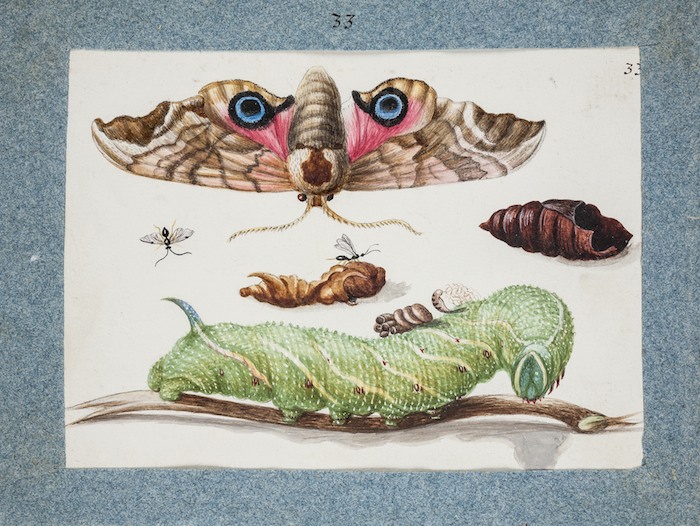
Fig. 3: Studienbuch pl. 14 fig. 33, Library of the Russian Academy of Sciences, St. Petersburg. (Click to enlarge)
Throughout their whole life cycle, she documented butterflies and moths being parasitized by wasps and flies. Not yet aware of the host-parasitoid relationship, she called these phenomena ‘false’ transformations. From a biologist’s point of view, Merian’s work is an important source of information on parasitology by introducing ecological information. For example, her depictions may show caterpillars with larvae of parasitic Apanteles wasps or pupae of parasitic tachinid flies on the outer surface of their dead host. Goedaert showed in his Metamorphosis an illustration depicting the emergence of parasitic wasps (Chalcididae) from a pupa of the Large Tortoiseshell (Nymphalis polychloros) (part 1, plate LXXVII) as well as larvae of parasitoids on the skin of a caterpillar (part 1, plate LXII), but these are exceptions to his work.
Merian reused her insect motifs several times. For example, she copied Goedaert’s caterpillar and pupa of the Magpie Moth (Abraxas grossulariata) from Metamorphosis (part 1, plate XXXI) for her Studienbuch, fig. 45, and appended a moth imago as well as a cluster of eggs (Beer 1976: pl. 18, fig. 45). She used these four motifs again in Der Rupsen Begin, voedzel en Wonderbaare Verandering […] [1717], (part 3, plate 29). The Magpie Moth depicted in her illustration is erroneously furnished with club-shaped antennae. This wrong detail was propagated through her work and reappeared in the aforementioned copper plate as well as in a watercolour and gouache on parchment with insects and plants (Sloane collection in the British Museum [BM, SL 5276 111]).
Almost always when Merian intended to show butterflies in flight, she presented them from an upper view as if she had drawn them from pinned specimens. In contrast, the painters Herman Henstenburgh and Johannes Bronckhorst from Hoorn, who also painted insects in flight, did succeed in presenting them in a more realistic manner. The perspective they adopted is defined as the three-quarter profile and comes very close to how butterflies really appear in flight. Actually, Bronckhorst was a teacher of Henstenburgh.
Comparing a pinned specimen of a Malachite butterfly (Siproeta stelenes) from a museum collection [http://commons.wikimedia.org/wiki/File:Siproeta_stelenes_meridionalis_MHNT_ventre.jpg] with Herman Henstenburgh’s depiction [https://rkd.nl/explore/images/119674 ], it is impressive to see how meticulously colour, shape and morphological structures (venation) are presented. Although Henstenburgh’s butterfly is shown from the underside and probably intended as an artistic drawing, it is very close to a scientific illustration and could easily be used for a field guide.
As we certainly can see from paintings of Anton Henstenburgh, Herman’s son, all three (the older and the younger Henstenburgh, and Bronckhorst) can be assigned to the same school. Again, Anton presented depictions of flying butterflies in the three-quarter profile. The younger Henstenburgh, who started painting at the age of 13, is successfully trying to be as detailed as possible (Braunschweig, Herzog Anton Ulrich Museum, Antoni Henstenburgh, Album H 27).
The following examples serve to demonstrate how I proceed in analysing paintings from a zoological perspective: The British Museum holds a painting of a flowering Marian thistle (Silybum marianum) with two insects (wasps) visiting the plant (ca. 1691-99, Sloane album, SL 5276.42)[http://www.britishmuseum.org/system_pages/beta_collection_introduction/beta_collection_object_details.aspx?objectId=709119&partId=1&searchText=SL%2c5276.42&images=true&people=115005&page=1]. It is not signed but was apparently painted by M.S. Merian or one of her daughters. The other one is a nearly identical copy and differs only in colouration and in some entomological details: beside the wasps, two caterpillars and two cocoons can be recognized. This artwork is in the Royal Collection of Windsor Castle (ca. 1705-1710, Reference: RL 21224 [http://www.royalcollection.org.uk/collection/921224/unused-design-for-the-metamorphosis-insectorum-surinamensium]. The practice of copying is widespread in Merian’s work.
Another very similar watercolour on vellum of a flowering Marian thistle is currently attributed to Maria Sibylla Merian, apparently because it contains lots of details of Merian’s thistle motifs and is even monogrammed ‘M.S.M’ (verso) [http://www.fitzmuseum.cam.ac.uk/dept/aa/opac/cataloguedetail.html?&priref=4827&_function_=xslt&_limit_=25]. However, a closer look reveals the three-quarter profile of a flying butterfly, a Speckled Yellow (Pseudopanthera macularia). As was discussed before, M. S. Merian does not depict flying butterflies and moths in a three-quarter profile. This insect seems more representative of a Henstenburgh or a Bronckhorst type of moth. Furthermore, the bird, a Purple Honeycreeper (Cyanerpes caeruleus), is obviously derived from at least one painting made and signed by Herman Henstenburgh: [https://rkd.nl/explore/images/120290]. Or take a look at the two land snails (Cepaea spec.) that are very likely to be from Henstenburgh’s hand. The land snail motif is commonly used in his still-life drawings. Therefore the question remains: Do we have proof for H. Henstenburgh’s attribution regarding the Cambridge painting? Did someone in the Merian workshop copy Henstenburgh’s thistle, and if so, when and where did that happen? The painter Herman Henstenburgh was active in the northern Netherlands between 1683 and 1726, but there is no evidence for Henstenburgh having ever left his hometown Hoorn. So I suggest that the painting found its way to Amsterdam by trading, where M.S. Merian or her daughters might have seen it, but further research needs to be done.
Therefore, it can be argued that scientific details can help to properly attribute artworks to their original creators. Take for instance one last comparative example. First, consider the painting of a St. Benedict’s thistle (Cnicus benedictus) and two Painted Ladies (Vanessa cardui) [http://www.britishmuseum.org/research/collection_online/collection_object_details/collection_image_gallery.aspx?assetId=326204&objectId=709121&partId=1]. It can undoubtedly be assigned to M. S. Merian, who apparently signed it (‘M. S. Me. fec.’). The butterfly is shown from above and from aside, with its wings slightly opened. Secondly, the watercolour ‘Branch of Pomegranate blossom and a split fruit, with Metamorphosis of the Painted Lady and Parasitic Wasps’ [http://www.lodiedue.com/fiere/1353925917_big.jpg]. It has traditionally been attributed to Maria Sibylla Merian. At first sight, one is indeed inclined to associate the signed painting (“M. S. Merian fec.”) with the artist.
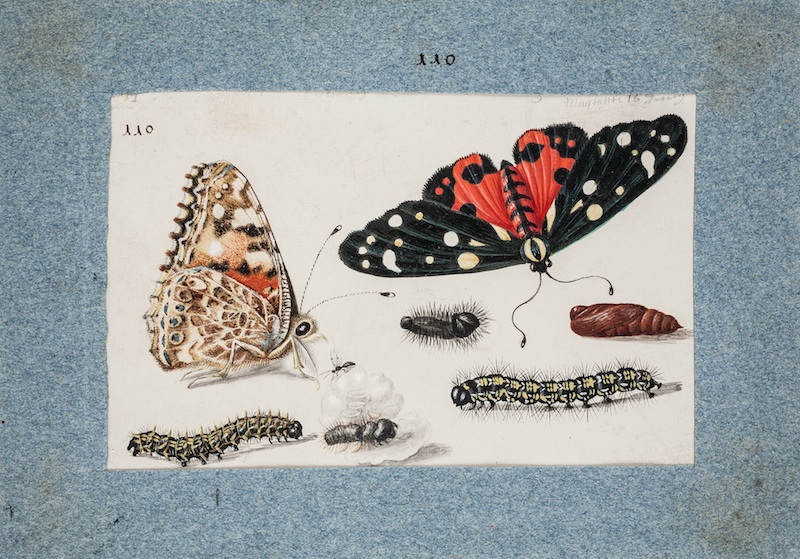
Fig. 4: Studienbuch pl. 41 fig. 110, Library of the Russian Academy of Sciences, St. Petersburg. (Click to enlarge)
But, again, look at the entomological details. First, the number of legs: in Merian’s original, she depicts two visible legs of the foot-brushed, nymphalid butterfly. In the Pomegranate copy, the same butterfly has three visible legs, the third one is fully developed. It is most unlikely that this error could have occurred to Maria Sibylla Merian. We can easily derive from the artist’s Studienbuch that she was familiar with the actual nymphalid anatomy and therefore correctly figured an anterior leg modified to form a foot-brush (Fig. 4). Second, the perspective is unusual for a work authored by Merian; while the upper butterfly is shown from above and appears very close to the model, the wings of the perching butterfly are depicted opened from the rear side, not from the fore side. So I suggest that the Pomegranate watercolour is from an unknown artist, but it is strongly influenced by Maria Sibylla Merian’s series of artworks depicting the ‘branch of Pomegranate blossom and split fruit’.
Conclusion: Considering biological details of an insect can help to assign attribution of naturalists’ artworks more reliably. For scientific work, high quality pictures and their proper digitization are urgently needed to study those details. This opens further opportunities beyond studying the primary document, which is indispensable whenever the original is accessible.
Suggested reading
Wolf Dietrich Beer (ed.), Maria Sibylla Merian: Schmetterlinge, Käfer und andere Insekten. Leningrader Studienbuch, 2 vols. Leipzig & Luzern 1976.
Vladimír Denkstein, Wenceslaus Hollar: Zeichnungen, Praha 1977.
Anne M. Zaal, Herman Henstenburgh (1667-1726), Hoorn: Stichting Vrienden van het Westfries Museum, Hoorn 1991.
[1] Beer 1976: Maria Sibylla Merian – Leningrader Studienbuch, Vol. 1 Tabula 54, pl. 53 no. 149, Vol. 2, p. 247.
[2] Beer 1976: Maria Sibylla Merian – Leningrader Studienbuch, Vol. 1 Tabula 78, pl. 77 no. 206.
Maria Sibylla Merian, Baltasar Scheid and Richard Bradley - some remarks on their letters and on incorrect transcriptions and translations of Merian letters, Brigitte Wirth, Göttingen, Germany
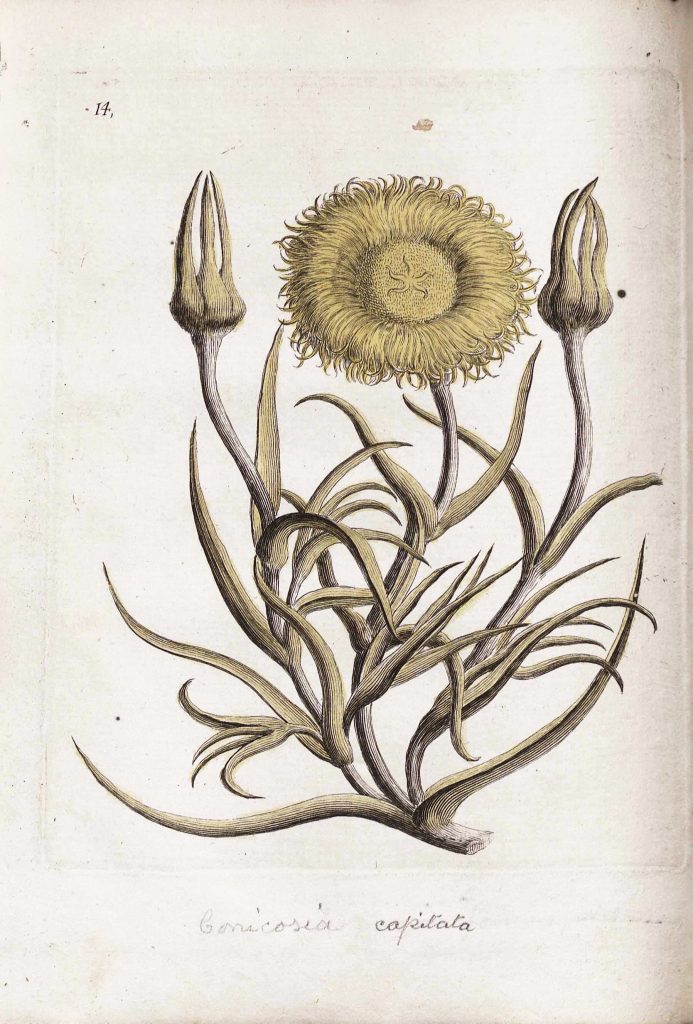
Figure 1. Pink leav’d Fig-Marygold. From: Richard Bradley, Historia Plantarum Succulentarum, Decade II, Plate 14, 1717. Image courtesy of the library of Kew Gardens, London. (Click to enlarge)
It was in the years between 1699 and 1708 that an Amsterdam trader named Baltasar Scheid (ca. 1660 – ca. 1724) wrote letters and sent plants, seeds etc. to Nürnberg to the physician and botanist Johann Georg Volkamer (1662-1744), informing him next to other interesting news also about the ongoing work of Maria Sibylla Merians’s Metamorphosis Insectorum Surinamensium. Scheid must have been well-known to Merian for she asked him to send in her name prints of copperplates of the Metamorphosis to Volkamer. Later, in 1714, the English botanist Richard Bradley (1688-1732) visited M.S.Merian during his stay in Holland to meet the artist who had contributed at least one painting for his Historia Plantarum Succulentarum. Bradley came into contact with Merian through James Petiver (1663-1718), apothecary in London, with whom Merian corresponded, and Bradley reported to him about his visit.
Baltasar Scheid
From the eighteen existing Merian letters we know that Maria Sibylla Merian had connections to Nürnberg as well as to London.1 The first of the extant Nürnberg letters was written in 1682 to Clara Regina Imhoff, a former pupil; the later ones up from 1702 to 1705 to the physician and botanist Johann Georg Volkamer. No further letters addressed to correspondents in Nürnberg are presently known. In these Nürnberg letters to Volkamer Merian mentioned several times a “Mr. Schey” or “Schrey” who did send on her behalf natural products and newly printed plates of the Metamorphosis to him (Merian letters 7; 8; 13; 14). This ” Mr. Schey ” is the Amsterdam trader Baltasar Scheid, who was also active for the same Volkamer until at least 1708. Up to 2007 Scheid was unknown in literature.2 Little is known about Scheid. According to Zacharias Conrad von Uffenbach (1683-1734), a scholar from Frankfurt am Main, Scheid was born around 1660 – his age is to be found only in the handwritten diary of his Merkwürdige Reisen durch Niedersachsen, Holland und Engelland from 1710/11, not in the printed copy of 1754.3 The Amsterdam apothecary Albertus Seba (1665-1736) wrote in 1724 to Volkamer about a very sick Scheid. Probably he died that year.4
The University Library of Erlangen, Dept. of Manuscripts, is in possession of 44 letters of Baltasar Scheid, written in the years between 1699 and 1708.5 In fourteen of these Merian is mentioned, but twelve are most interesting for us because he wrote about the ongoing work on Metamorphosis Insectorum Surinamensium. In these letters Scheid also informed Volkamer about the progress on the Amboinsche Rariteitkamer by Georgius Everhardus Rumphius (1627-1702), as both books were of great interest to Volkamer.
From these letters we learn that the printing of Metamorphosis started between March and April of 1703 rather than in June of that year. Scheid sent the subscription conditions in March and a first proof in April to Volkamer (Scheid letters 18; 19), whereas Merian only promised a proof in October 1702, but did not send one before June 1703 to the London apothecary James Petiver (Merian letters 8; 9). Moreover, still following Scheid, the printing work was terminated in February 1705, when he ordered the colouring of a copy of Metamorphosis for Volkamer. As he never wrote about an order for colouring before that date, we can assume that the printed volume was ready in February 1705.6
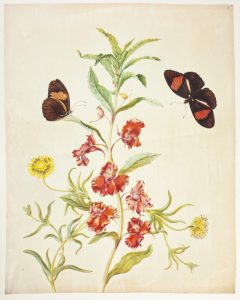
Figure 2. Maria Sibylla Merian, Impatiens balsamina, Lampranthus sp., Heliconus cf. Malpomene, 1695, watercolour and gouache on vellum. Reproduced by permission of the Russian Academy of Sciences, St. Petersburg, inv. nr. 10-85-5. (Click to enlarge)
Thus, the production progress between the beginning and end went as follows: from April to September 1703, 15 copperplates were engraved according to Scheid (Scheid letters 19;24). In October 1703, Merian herself wrote that 20 plates would soon be finished (Merian letter 11). In April 1704 she wrote that more than 30 copperplates had been produced (Merian letter 12). Early July Merian was thinking of printing the accompanying text, wrote Scheid (Scheid letter 26). By the end of that month 50 plates had been engraved (Scheid letter 27), and in February 1705 the entire set of 60 copperplates was finished (Scheid letter 29). Thus, according to Baltasar Scheid, the work on the plates of Metamorphosis started and ended earlier than described in the information given by Merian herself.
Just some further remarks on Scheid’s letters: we read that Madame Merian avancirt wacker mit ihrem Werck (is proceeding pretty well with her work), whereas publisher François Halma has always new excuses as to why the work on Rumphius’s Rariteitkamer is taking such a long time (Scheid letter 26). Scheid also complained about the quality of the paper for the Rariteitkamer, while writing that Madame Merian has used a much better paper. We also learn from Scheid that Frl. Merian (i.e. young lady Merian = Dorothea Maria) did the colouring of the Metamorphosis for Volkamer’s brother (Scheid letter 30). This I think is the only written information about the teamwork of mother and daughter Merian.
Richard Bradley
The English addressee of Merian’s letters was James Petiver with whom she corresponded till at least 1712; he was the link between Merian and Richard Bradley. At the time, Bradley was known for his numerous publications on gardening, husbandry and agriculture. Although he did not hold a university degree, he was elected the first Professor of Botany at Cambridge. In 1712 he became Fellow of the Royal Society through the support of Petiver and Sir Hans Sloane (1660-1753), all of whom were very interested in natural history. Bradley had for long specialized in succulents and issued his Historia Plantarum Succulentarum, a work in five decades of ten plates each, in the years between 1716 and 1727.
For his succulent work, Bradley sought the help of Petiver for whom he made drawings or collected natural history specimens. As we know from Merian’s letters, Petiver owned copies of her books and he also had some paintings of hers that he could have bought during his stay in Holland in 1711.7 Bradley may have seen Merian’s work in Petiver’s house. It is fairly certain that Petiver had told Bradley about his visit to Merian’s house and about one of her paintings of the Aster ficoides, for he knew about Bradley’s interest for these plants. This explains Bradley’s request in a letter to Petiver, written between 1711 and 1714: please to Intimate that what Draughts of Ficoides are Done by Mad:m Marian [sic] may not Exceed the Quarto Size.8
Now it seems possible that Merian did such a painting for Bradley indeed, for she was most interested to become better known in England and to gain new customers there. Plate 14, Deca
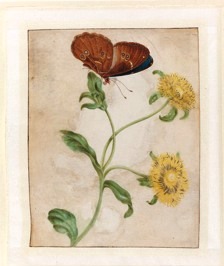
Figure 3. Maria Sibylla Merian, Yellow aster and butterfly, 1695, watercolour on vellum, drawn for Agnes Block. Reproduced by permission of the Rijksprentenkabinet, Amsterdam, inv. nr. RP-T-1947: 214. The drawing represents Aster ficoides ayzoides and an unidentified Morpho from South America. (Click to enlarge)
de II (1717) from Bradley’s Historia Plantarum Succulentarum shows Ficoides capensis (Figure 1). Ficoides is an old name for the family Mesembryanthemaceae, and there is a very similar painting by Merian in St. Petersburg of another Ficoides, presently named Lampranthus (Figure 2). Another painting by Merian of a Ficoides is kept in the Rijksprentenkabinet in Amsterdam (Figure 3). The way of drawing the fleshy leaves as well as their base and blossoms is nearly the same. The whole plant represented in Figures 1 and 3 is done in an elegant and harmonious way and very different from Bradley’s Plate 43, Decade V (1727) of the related Ficoides Africana folio triangulari. The latter was very probably drawn by Bradley himself (Figure 4) and this purely scientific drawing is absolutely incomparable with Merian’s artistic drawings.
When traveling to Holland in 1714 to collect rare plants and seeds as well as insects and to draw whatever could be of interest to Petiver and the Duchess of Beaufort (1630-1715), Bradley visited Merian. He wrote to Petiver (July 1714) that he was overwhelmed by what he saw in her house.9 Everywhere were original paintings: of the Rariteitkamer, of her Raupen, 32 leaves of fine birds, a large folio of plants from the Amsterdam Garden that may be the same volume as the one mentioned by Von Uffenbach,10 and the two volumes in folio of Commelin’s Horti Medici Amstelodamensis with the prints Colour’d after the Life. And for all this he mentioned prices, namely: 100 Guineas for the Rariteitkamer, that is more than 1000 florins; for the Raupen 500 florins; the 32 birds she wanted to sell for 400 florins; the large folio with the plants from the Amsterdam Garden for 600 florins and Commelin’s work should cost the amount of 200 florins. The last one she probably sold for her daughter Johanna Helena (at that time in Surinam), who contributed some paintings to the Atlas Moninckx which contains originals for the Horti Medici Amstelodamensis, and who might have coloured some of these books as well.11
The price for the Raupen given by Bradley is quite interesting for a comparison with other quotations. But it should be taken into consideration that in July 1714 perhaps all of the paintings for Part III had been done; this means a cost of 500 florins for 150 paintings on parchment, or nearly 170 florins per book containing 50 plates each. The same book with 50 plates gemahlt (painted), meaning coloured counterproof or replica on paper for 20 florins (Merina letter 17), a book with 50 plates coloured for 10 florins (Merian letters 11; 17), and an uncoloured copy for only 2 ½ florins (Uffenbach,Teil 3: 552-554). Obviously, there is an enormous difference between a painted work on parchment and a simple black and white print.
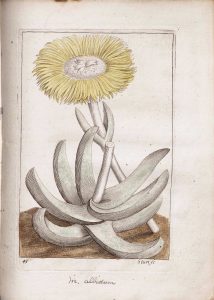
Figure 4 The Dwarf-Triangular White-leaf’d Fig-marygold. From: Richard Bradley, Historia Plantarum Succulentarum, Decade V, Plate 43, 1727. Image courtesy of the library of Kew Gardens, London. (Click to enlarge)
Transcriptions and translations of Merian letters
Merian’s letters have been transcribed by Stuldreher-Nienhuis and Rücker.13 Both refer to the same original handwriting, but differ very often in transcription. Is it Tugentreiche(St.-N.) or tugent Reiche (R.), Frauenzimmer (St.-N.) or frauwenZimer (R.), Vatter (father) (St.-N.) or Vetter (cousin) (R.) (Merian letter 1 (St.-N.), i.e. letter 2 (R.))? Another example: sometimes Stuldreher-Nienhuis writes more words in a sentence than Rücker does. However, the old way of writing a word cannot be changed into the modern way, or words within a sentence should not be changed. Likewise, the translation of the letters from German into English is sometimes problematic, but 2 muschel grundfarb has nothing to do with 2 shells of ground colour, it simply means Primärfarbe = primary colour, i.e. blue, yellow or red (Merian letter 3).
Another example: the translation from the letters written in Dutch or French into German and English is often wrong. If the original is written in present tense, one should not transfer into imperfect tense: Les Biliettes contiennent cannot be translated into the letters contained, it means instead: they contain. Souhaiter remains to wish and should not be changed into hésiter – to hesitate. And il en est prèst plus que la moitie means more than half of it is finished and not almost half is finished. To translate L0 procent into 50 percent is nonsense, Merian actually did not want to pay 10 percent to Levinus Vincent (all these examples from Merian letter 12). In letter 17 the sentence: … so kost … das in quart 20 fl hollendisch, der eines in [ … ] erwagen hoffe gethan zu haben … should be corrected into: … deren eines in 3 wogen hoffe gethan zu haben … In letter 18, written in Dutch, Merian offered 2 duysent been to Petiver. This is translated into two thousand bones, but Merian never sold bones! What she offered were two centipedes or millipedes, Ella Reitsma and Sandrine Ulenberg give the correct translation.13
Obviously, it seems to be necessary to review all transcriptions as well as all translations of Merian’s letters. That would be a good aim to set before the next commemoration in Amsterdam in 2017, on the occasion of the 300th anniversary of her death.
Endnotes
- The numbers of the Merian letters refer to Wettengl, K. (1997: 262-269).
- Wirth (2007); Kinukawa (2011).
- Uffenbach, Z.C. von, 1710/11. Merkwürdige Reisen durch Niedersachsen, Holland und Engelland, Staats- und Universitätsbibliothek Göttingen, Handschriftenabteilung, Nachlaß Uffenbach, 80 Cod. Ms. Uffenbach 25, Teil 3, p. 703.
- Wirth (2007: 123).
- Universitätsbibliothek Erlangen, Briefsammlung Trew – Baltasar Scheid – letters numbered 1-44; Wirth (2007: 116).
- According to the newspaper Opregte Leydsche Courant, the printing of the edition of Metamorphosis with letterpress in Dutch was ready on 2 March 1705, while the edition with Latin text was still in press.
- Van Gelder (1997: 148-149).
- Henrey (1975, 2: 429).
- Tjaden (1974, 9 (1): 9).
- Uffenbach (1754, Teil 3: 552-554). Uffenbach did not say that these plants were drawn from the Amsterdam hortus.
- Wirth (2007: 143).
- Stuldreher-Nienhuis (1944: 171- 174); Rücker (1982: 61-75).
- Reitsma & Ulenberg (2008: 226).
References
- Gelder, R. van, 1997. Zwischen Kunst, Kommerz, Liebhaberei und Wissenschaft. In: Wettengl (Ed.) 1997: 136-149.
- Henrey, B., 1975. British Botanical and Horticultural Literature before 1800. 3 vols, London.
- Kinukawa,T., 2011. Natural history as entrepreneurship: Maria Sibylla Merian’s correspondence with J.G. Volkamer II and James Petiver. Archives of Natural History, 38 (2): 313-327.
- Reitsma, E. & Ulenberg, S., 2008. Maria Sibylla Merian & Daughters. Women of Art and Science. Amsterdam, Los Angeles & Zwolle.
- Rücker, E., 1982. The letters. In: Rücker, E. & Stearn, W.T. (Ed.) Maria Sibylla Merian in Surinam. London: 61-75.
- Stuldreher-Nienhuis, J., 1944. Verborgen paradijzen. Het leven en de werken van Maria Sibylla Merian 1647-1717. Arnhem.
- Tjaden, W., 1973-1976. Richard Bradley, F.R.S. 1688-1732, Succulent Plant Pioneer. The Bulletin of the African Succulent Plant Society (ASPS) 8 (4), pp.132 et seq. (18 sequences).
- Uffenbach, Z.C. von, 1754. Merkwürdige Reisen durch Niedersachsen, Holland und Engelland, Teil 3. Ulm.
- Wettengl, K. (Ed.), 1997. Maria Sibylla Merian, 1647-1717; Künstlerin und Naturforscherin. Frankfurt am Main.
- Wirth, B., 2007. Maria Sibylla Merian, Baltasar Scheid und Richard Bradley – Die Künstlerin und Naturforscherin, ein Kaufmann und ein Botaniker. In: Annals of the History and Philosophy of Biology, 12: 115-153.
Exploring and Presenting Merian*, Kurt Wettengl, Frankfurt am Main, Dortmund, Germany
In the seventeenth and early eighteenth century artist and naturalist Maria Sibylla Merian was a remarkably self-reliant woman of diverse talents. The story of her life is by no means typical for her time. Born the daughter of the renowned publisher Matthäus Merian the Elder in Frankfurt am Main in April 1647, she spent the most important phases of her life in Frankfurt am Main, Nuremberg, in a Labadist community in Friesland, and in the cosmopolitan city of Amsterdam. In 1699 she embarked in the company of her daughter Dorothea on a dangerous voyage to the Dutch colony of Surinam to study the world of exotic butterflies. Maria Sibylla Merian received her training in the art at the hands of her stepfather Jacob Marrel, a student of Georg Flegel, the first of the German still-life painters.
Maria Sibylla Merian began observing insects at the age of thirteen. It was not long before she undertook her first systematic studies of butterflies, which, although still largely unknown to science in the mid-17th century, were the subject of empirical studies undertaken by a number of naturalists in Merian’s time. Aside from flower and fruit still-life studies, Maria Sibylla Merian now began to paint, in meticulous detail, vivid watercolours depicting butterfly metamorphoses and the plants upon which the animal fed. The mother of two daughters and separated from her husband since about 1685, Merian was also teacher and businesswoman. She instructed women in drawing and dealt in paints as well as butterfly and reptile specimens she preserved herself. As a publisher, she issued her early “Blumenbuch“ (Book of Flowers), two volumes of her “Raupenbuch“ (Book of Caterpillars) and her large format magnum opus entitled Metamorphosis Insectorum Surinamensium, a work on Surinamese butterflies that was to earn her widespread acclaim.
Maria Sibylla Merian’s work earned her considerable admiration during her own lifetime and throughout the eighteenth century. The Swedish naturalist Carl von Linné consulted many of her illustrations in the course of his work on a system of taxonomy around the middle of the eighteenth century, in some cases even examining insects prepared by Merian. However, in the nineteenth century her work was subjected to severe criticism. In the eyes of the British naturalist Reverend Lansdown Guilding, for example, her most important work Metamorphosis was full of error, its illustrations rough and worthless. Accusing the book of having an “anthropological flair”, he criticised, in the name of the ostensible scientific objectivity, Merian’s interest in the cultural traditions associated with the exotic plants and insects she had studied in the Dutch colony of Surinam. Neither Merian’s methods nor her artistic presentation were acceptable to those who subscribed to a systematizing taxonomic biology as a natural science, while the demise of natural history represents a significant mid-nineteenth century caesura in the critical reception of Merian’s research. Indeed, Maria Sibylla Merian was largely ignored not only by the scientific community but by students of art as well for quite a long time. We should not fail to note, however, that for many years the general public was familiar for the most part only with her copper engravings. Viewed from the standpoint of an art history that showed no interest in natural science – and thus in the context in which Maria Sibylla Merian’s oeuvre originated – her work was regarded at best as “applied” art and illustration for a great many years.
The life and work of Maria Sibylla Merian has been the subject of considerable scholarly attention during the latter half of the twentieth century. During the period from 1940 to 1960, J. Stuldreher-Nienhuis, Margarete Pfister-Burkhalter and especially Elisabeth Rücker made significant contributions to the artist’s biography. An early highlight in the renewed interest in Maria Sibylla Merian as an artist was the exhibition in 1967, curated by Elisabeth Rücker. It was the first large-scale exhibition, shown at the Germanisches Nationalmuseum in Nuremberg in commemoration of Maria Sibylla Merian on the occasion of the 250th anniversary of her death.
But ever since that exhibition the work of Maria Sibilla Merian was explored very intensively: During the early 1970s the Leningrad watercolours, as they were called at the time, and Maria Sibylla Merian’s Studienbuch (Book of Studies) were published in facsimile editions. In the early 1980s Elisabeth Rücker and William T. Stearn edited the facsimile edition of Metamorphosis Insectorum Surinamensium. The publication of these three works went hand in hand with a rigorous botanical and entomological assessment of Merian’s oeuvre. Since the late 1970s, feminist scholars in the fields of art, history, and literature have focused their attention on Merian’s life and work as well. Natalie Zemon Davis published a rigorous, richly documented Merian biography based upon an approach from different perspective in 1995.
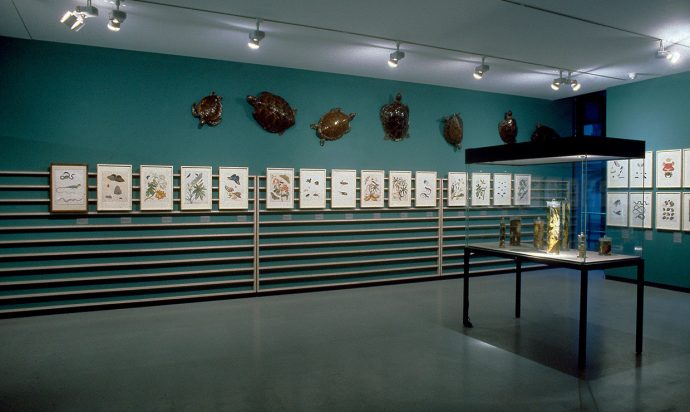
Fig 1. Impression of the exhibition in Frankfurt am Main in 1997 zwischen Frankfurt und Surinam”. (Click to enlarge)
The Historisches Museum in Frankfurt am Main welcomed the 350th anniversary of Maria Sibylla Merian’s birth in 1997 as an opportunity to present a comprehensive exhibition on the work of this noteworthy artist and naturalist (Figs. 1-2). Following the completion of the Frankfurt showing in the winter of 1997/98 the exhibition moved on to the Teylers Museum in Haarlem. Some hundred parchment water-colours, the unique Studienbuch and Merian’s exceptionally rare, hand-coloured copper engravings – the early Blumenbuch, the Raupenbuch and her large-format Metamorphosis – formed the focal points of the presentation. Many of the beautiful watercolours depicting insect metamorphoses and food plants were exhibited for the first time. Worthy of particular note among these were 43 watercolours from the St. Petersburg Archives of the Academy of Sciences, which were acquired by Tsar Peter the Great along with other works by the artist in early 1717.
The exhibition was structured according to the successive phases of Maria Sibylla Merian’s life. Its chronological and topographical sequence covered a variety of thematic aspects of particular relevance to her oeuvre. At the same time, an effort had been made to place Merian’s work within the context of the history of natural science in the seventeenth and eighteenth centuries – as represented by the scientific works of other artists and naturalists, insect and floral still-lifes by Dutch women painters and preserved animal specimens, like reptiles and butterflies from Johann Christian Gerning, an important collector, whose collection is in Wiesbaden nowadays (a collection Joos van de Plas worked with during the last years).
There was one enormous problem, a gap that exists until today, and it has to be discussed how to handle it in the next future. Different works attributed to Maria Sibylla Merian, like watercolours or coloured engravings, are now held in many European and North American museums, libraries, archives, and private collections. There is no critical catalogue of Merian’s oeuvre. In the course of preparation and research for my exhibition in 1997 it was determined that many of these attributions to Maria Sibylla Merian are either questionable or fully unjustified. The principles used in selecting the works to be exhibited were intended to focus upon a standard of quality in Merian’s works against which other works might be compared. Nevertheless, the exhibition featured several watercolours whose acceptance as works of Maria Sibylla Merian’s is likely to be the subject of considerable discussion and controversy. But this, too, was one of the exhibition’s objectives: Distributed among a number of different cities and collections and never before exhibited together, the drawings, paintings, prints and books presented here offered an excellent opportunity for comparative evaluation. However, that evaluation has still to be done until today.
In 2003 I had the opportunity to curate a permanent exhibition in the Senckenberg Museum in Frankfurt am Main, a world-wide leading Museum for Natural History and a Center for Biodiversity. The exhibition has the title: “From natural history to natural science. Maria Sibylla Merian and the natural cabinets in Frankfurt in the 18th century”. The focus was the work of Merian as far as it could be represented by her work in the collection of the Senckenberg Museum and Library on one hand and the private collections – like Gerning and others – in Frankfurt on the other hand. The invitation of an art historian by this institution is one of the signs of a fundamental change in the theoretical approaches to science that have become increasingly apparent during the last decades of the twentieth century. Among the most noteworthy features of this process of reassessment is a critical re-appraisal of the traditionally predominant distinction between scientific knowledge and other forms of knowledge – the phenomenology of nature on the one hand, and aesthetics, on the other hand, natural history here, art history here or art on the one hand or knowledge of art history on the one hand and knowledge of artists on the other.
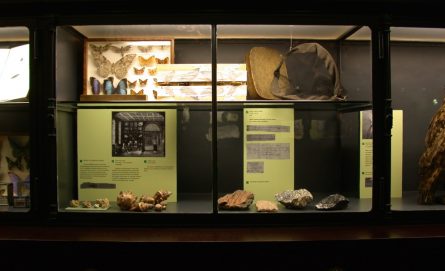
Fig. 3. Impression of the permanent exhibition in the Senckenberg Museum in Frankfurt am Main. (Click to enlarge)
In 2008 Ella Reitsma curated an exhibition in Amsterdam, supported by the entomologist Sandrine Ulenberg, titled: “Maria Sibylla Merian & daughters”. The exhibition – afterwards shown in the Getty Museum – was structured according to the successive phases of Maria Sibylla Merian’s life, like our exhibition in 1997. It was already in 1997 that I stressed that a look at contemporary approaches to the relationship between art and science may be of help to us to understand and assess both Maria Sibylla Merian’s work as an artist-naturalist and the unity of art and science that still existed, at least as a potential, in the seventeenth century. This bond was severed during the eighteenth century, as natural history gave way to natural science. After the avant-garde-artist Marcel Duchamp, many artists since the 1960s did investigations into the relationship between art and science and art and nature. Worthy of note in this connection are Hans Haacke’s “real time systems” of the 1970s or the artist Paul Armand Gette, who was an artist and a trained zoologist. Since the nineties installations dealing with nature attracted attention at many exhibitions. And today there are a lot of artists dealing with biology and art, some of them are both artists and biologists, or they were trained in biology.
It should be discussed in this conference [from now on?] how knowledge about Maria Sibylla Merian’s working process and work could be improved and that means of course: it should be considered how it could be managed to make a critical catalogue. Of course – in my opinion – this is a work of collaboration. A collaboration across the borders and limitations of the sciences: a collective work of biology and botany, ethnology, history, history of the natural sciences and art history. And: including knowledge of artists like Joos van de Plas or others like Marc Dion etc. And also: including the enormous knowledge of filmmakers like Jo Francis and John Fuegi from Kopenhagen. Such a catalogue raisonné in progress as collective work could be published on a world-wide-web platform. My hope for the forthcoming conference: Let us find a new way to explore Merian’s work – the artworks themselves and of course the context she was working in.
* This text follows the introduction of the author, in: Kurt Wettengl (Ed.): Maria Sibylla (1647 – 1717) Merian. Artist and Naturalist, Ostfildern 1998 (Hatje, Thames/Hudson).

